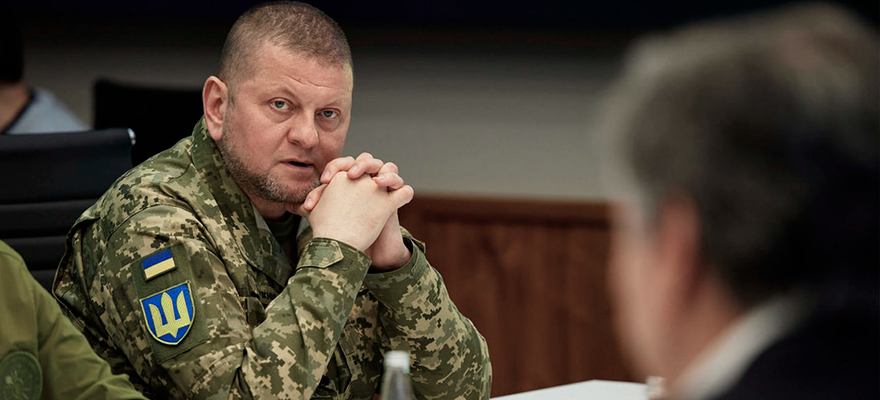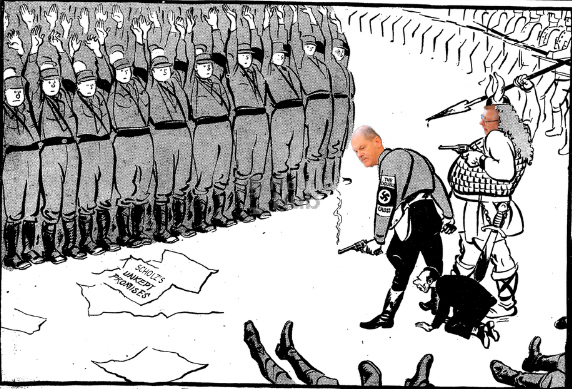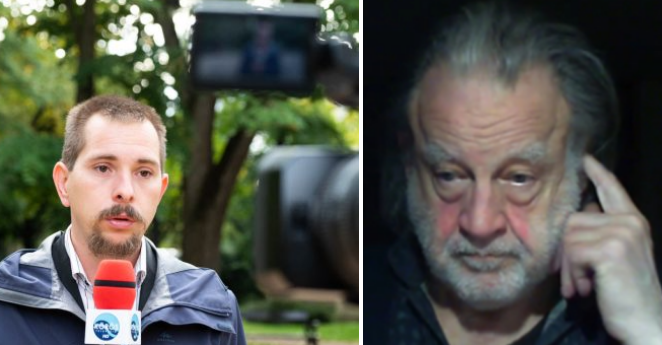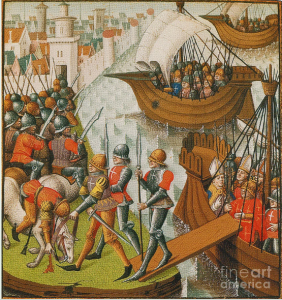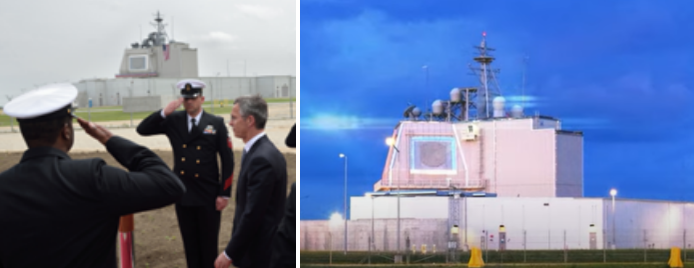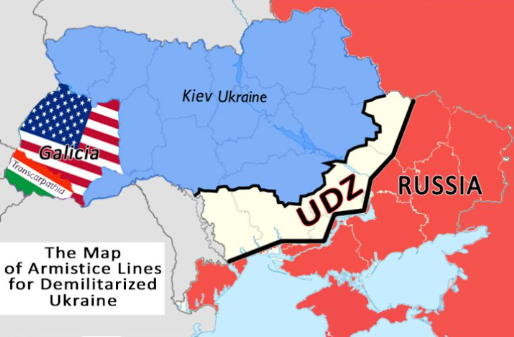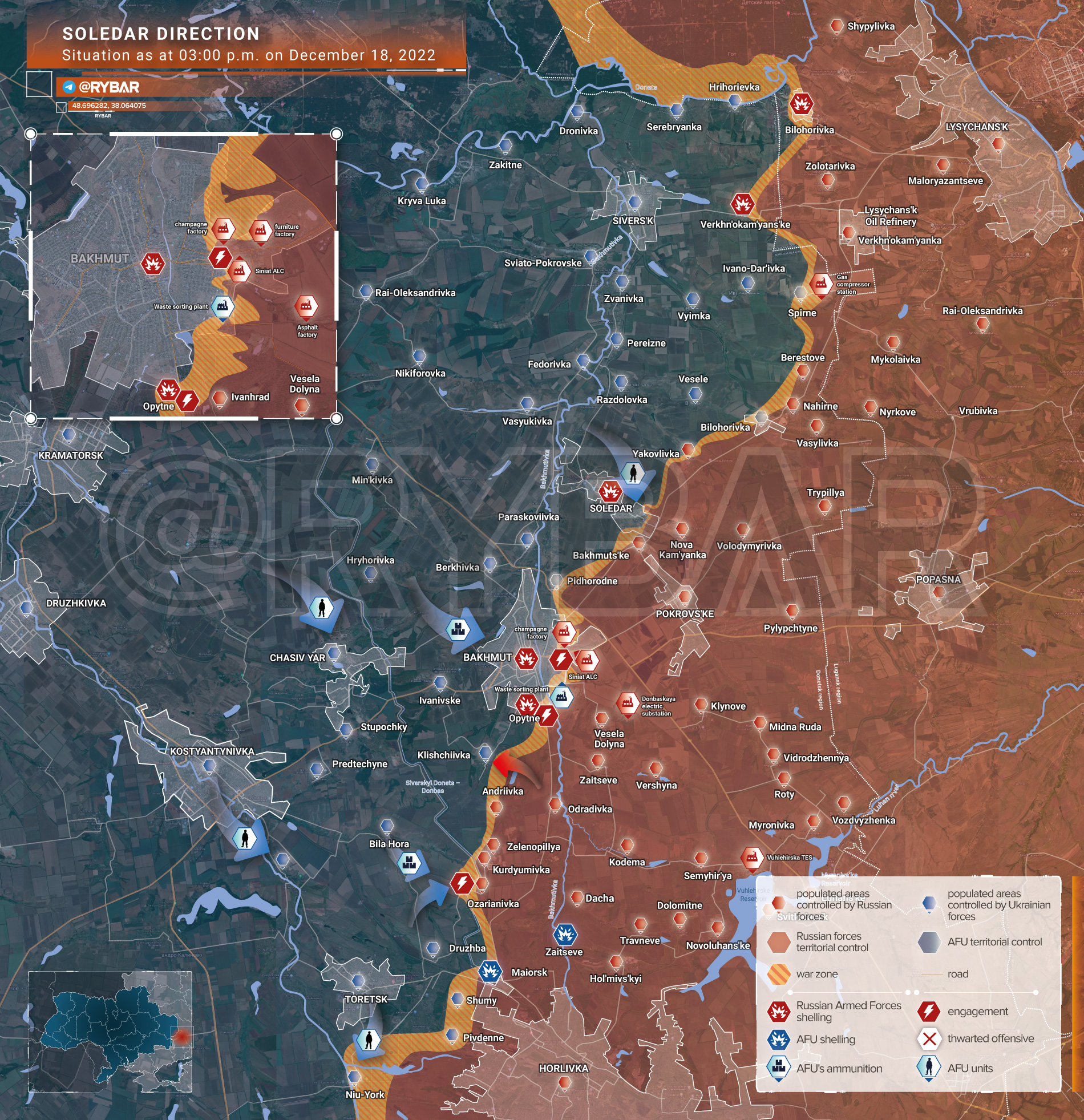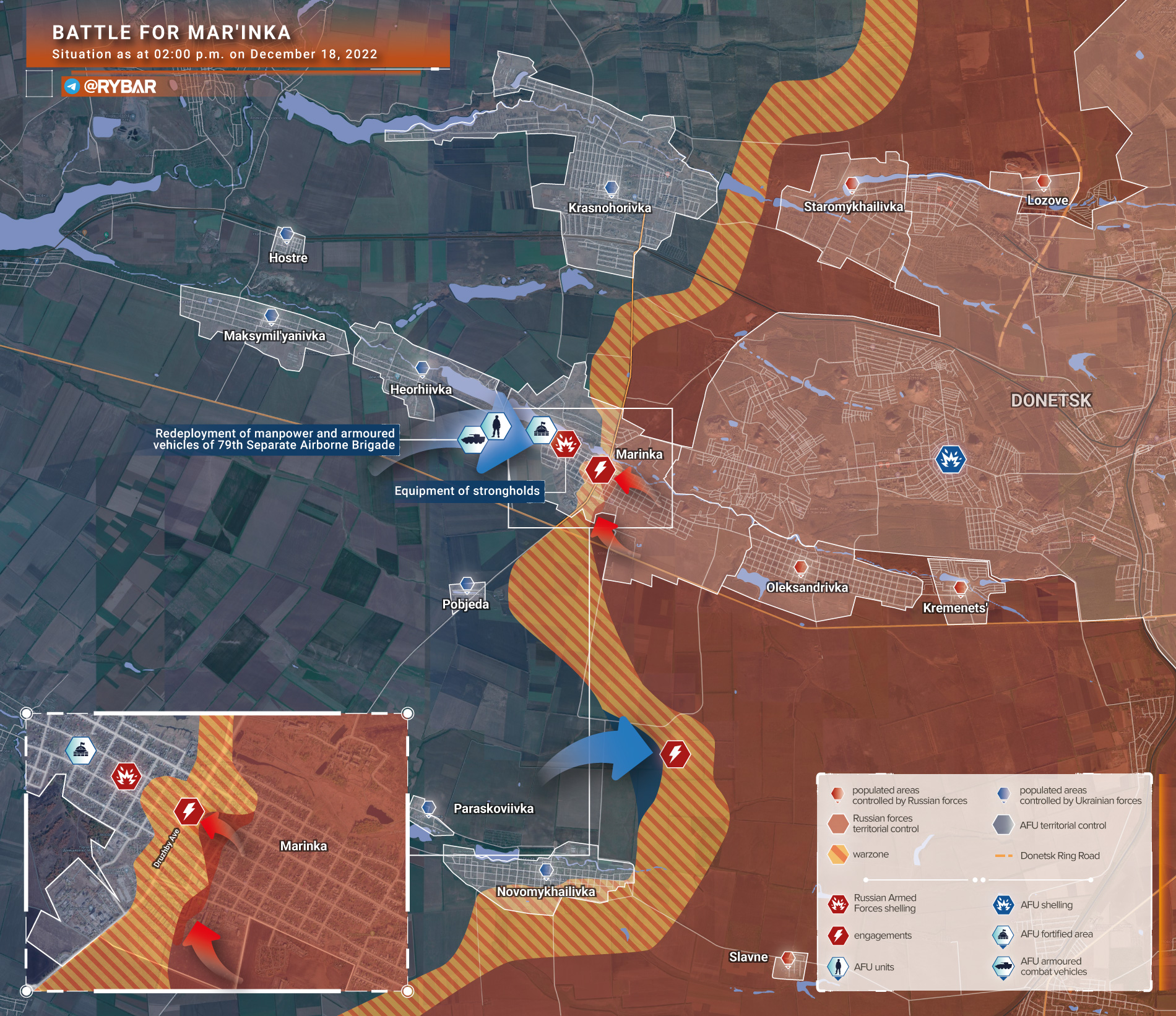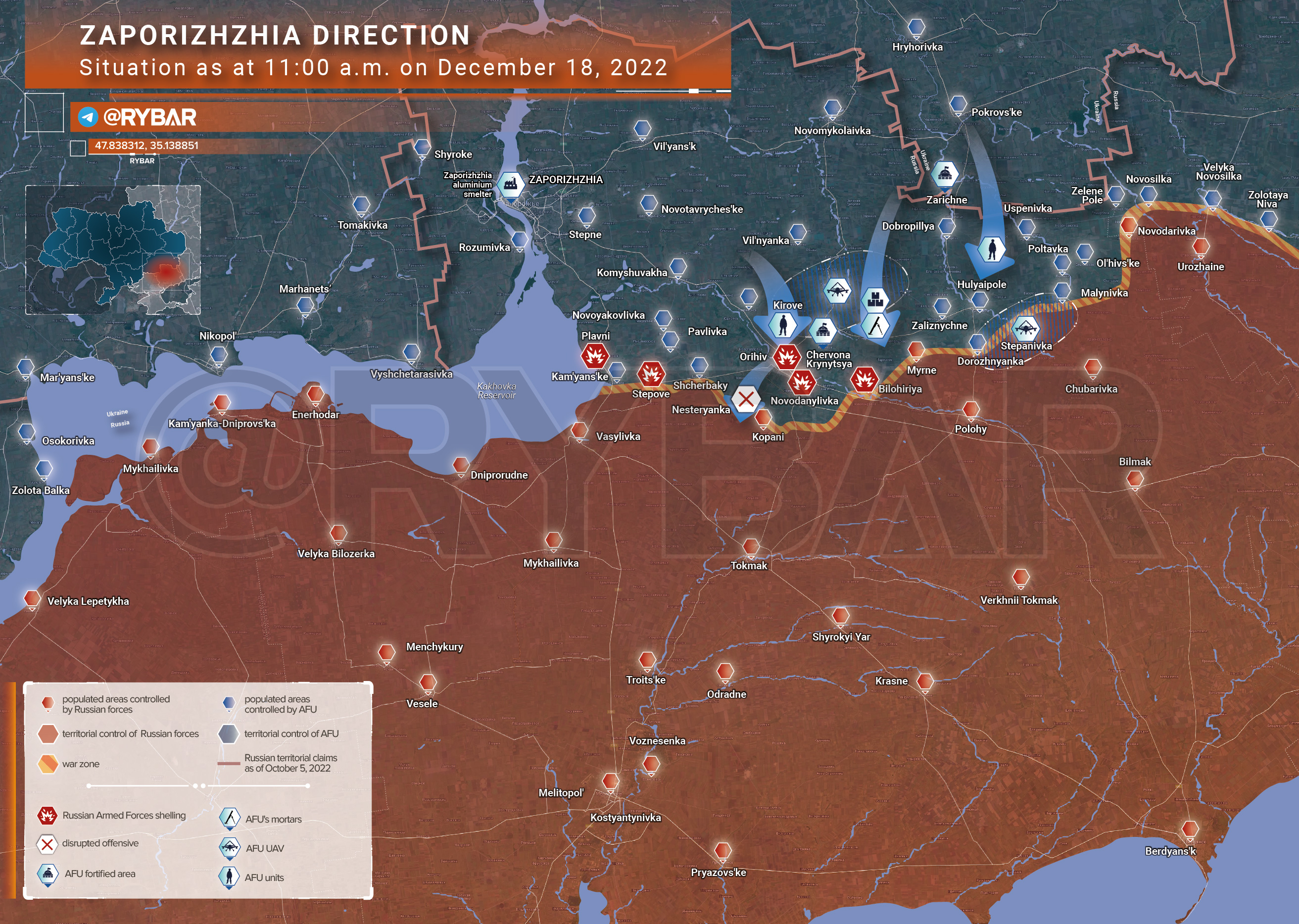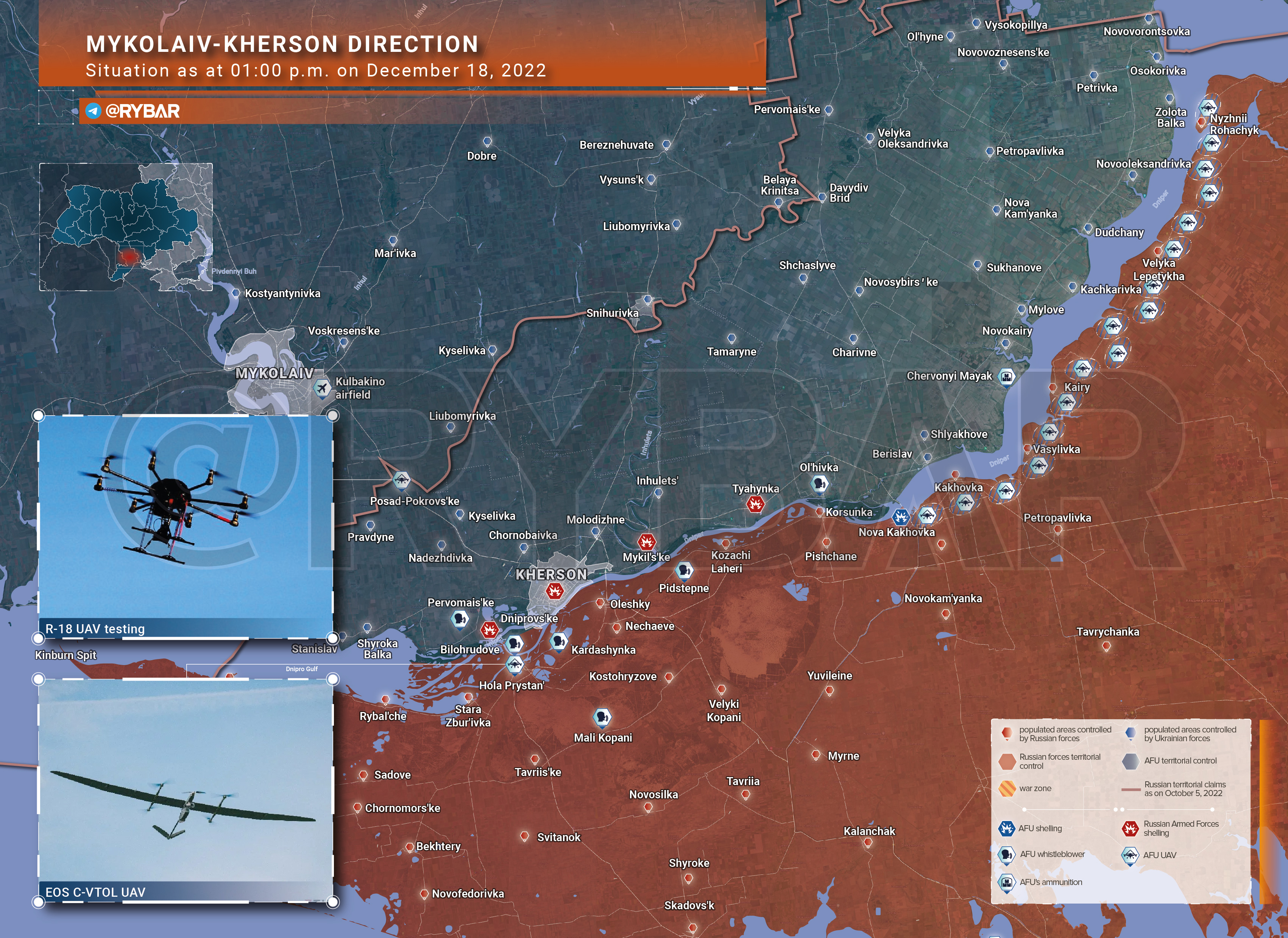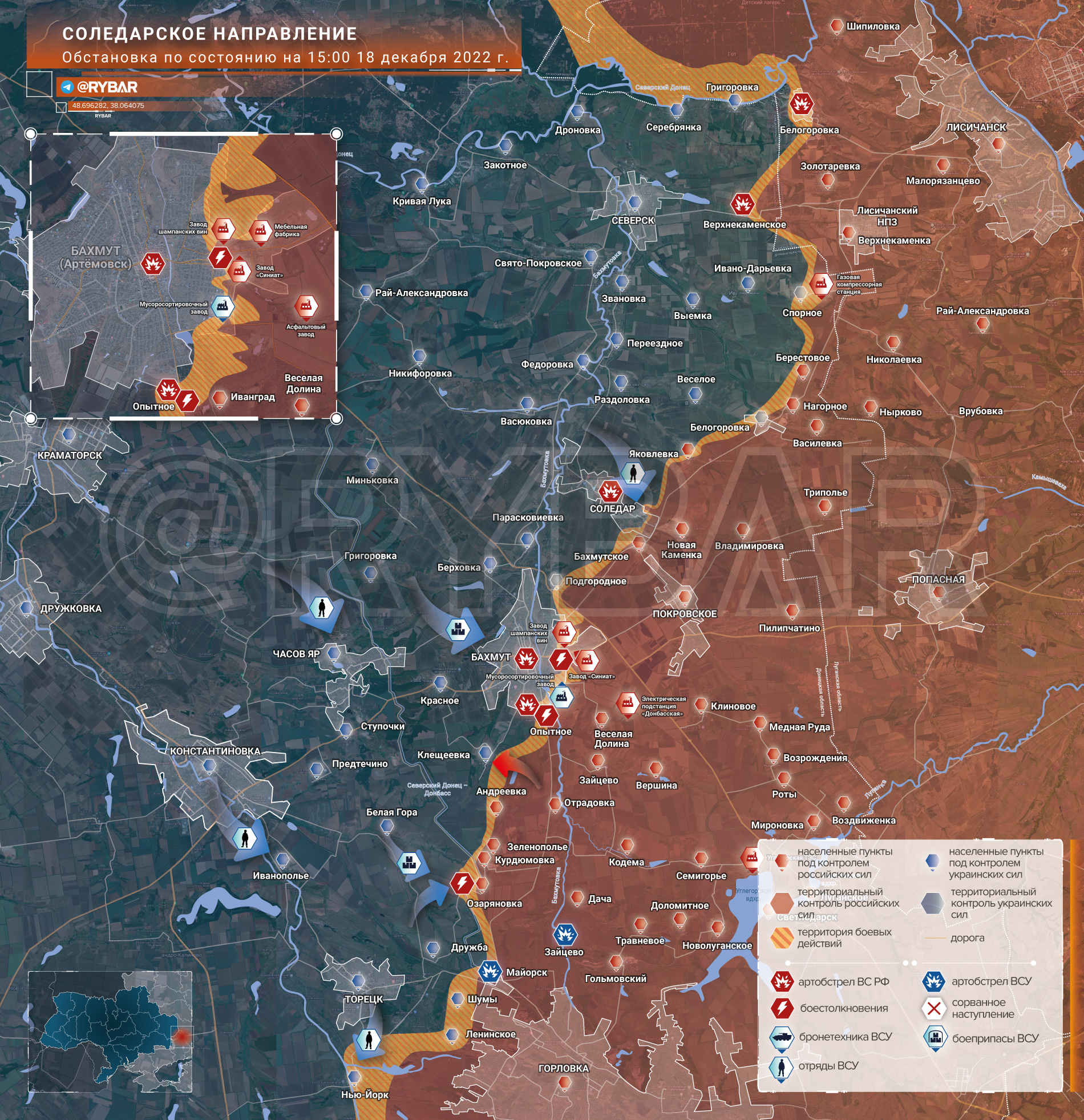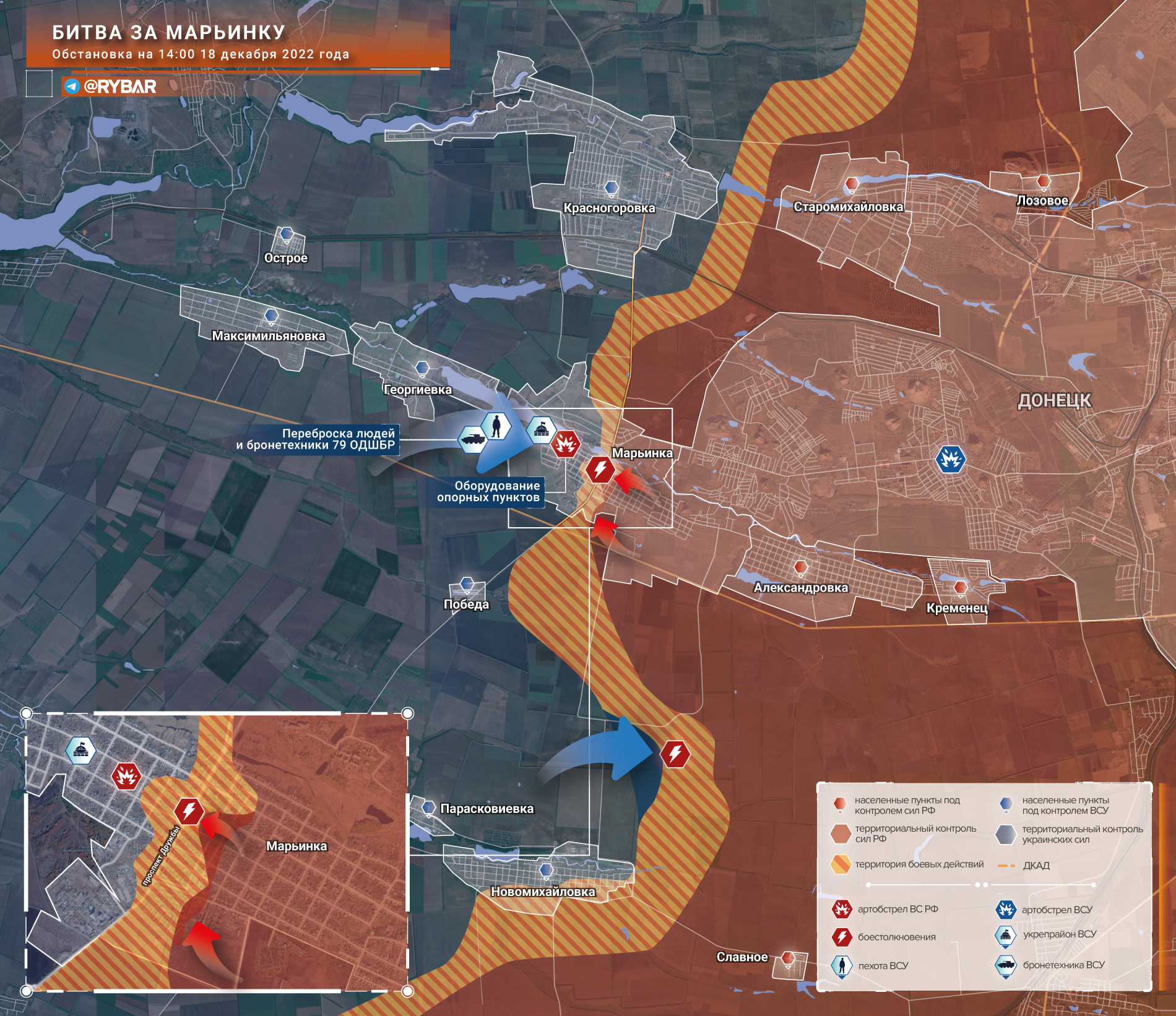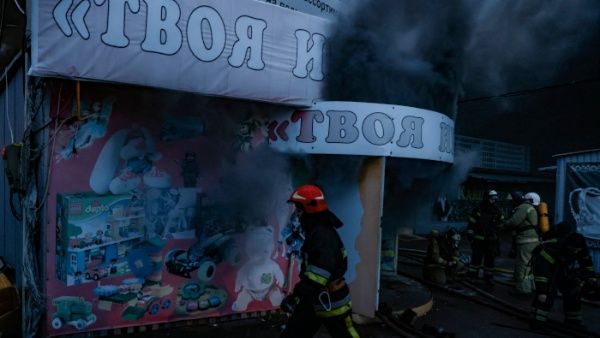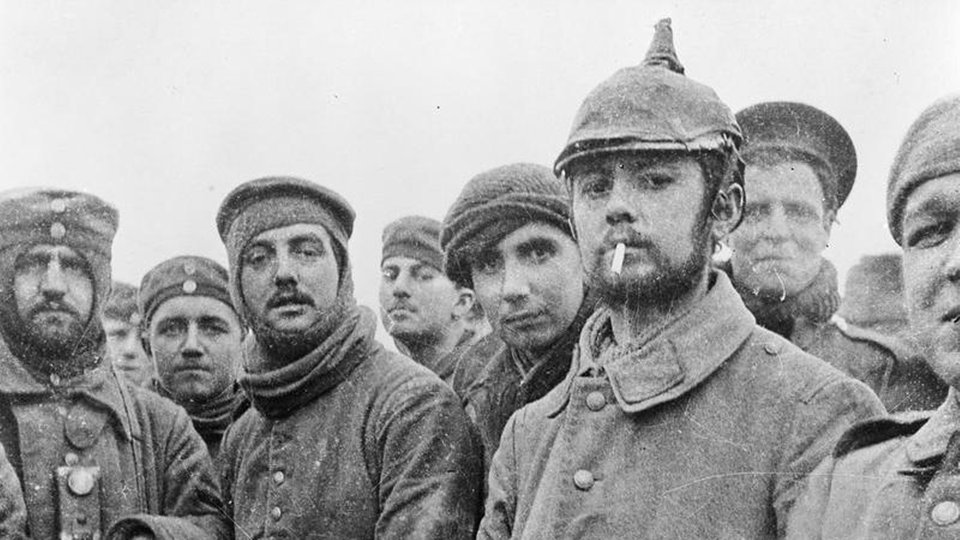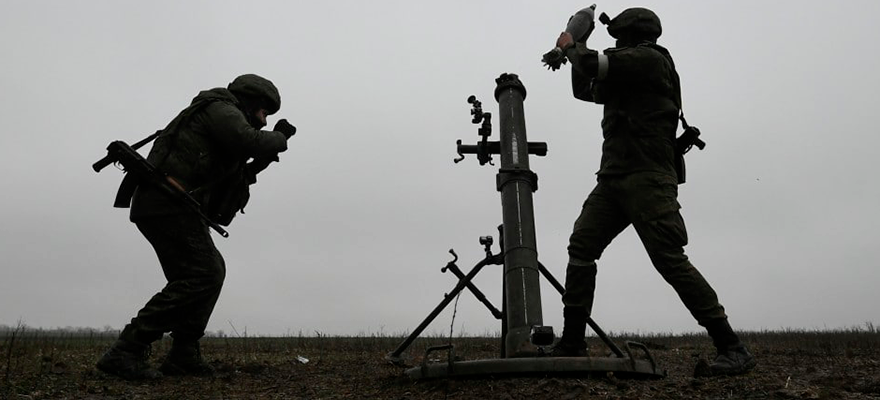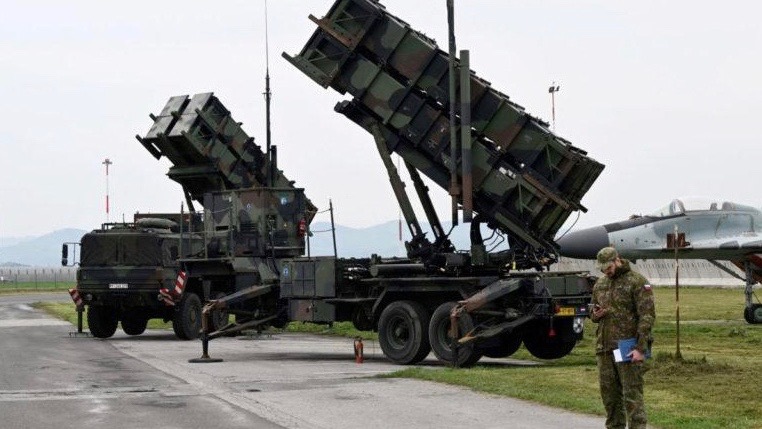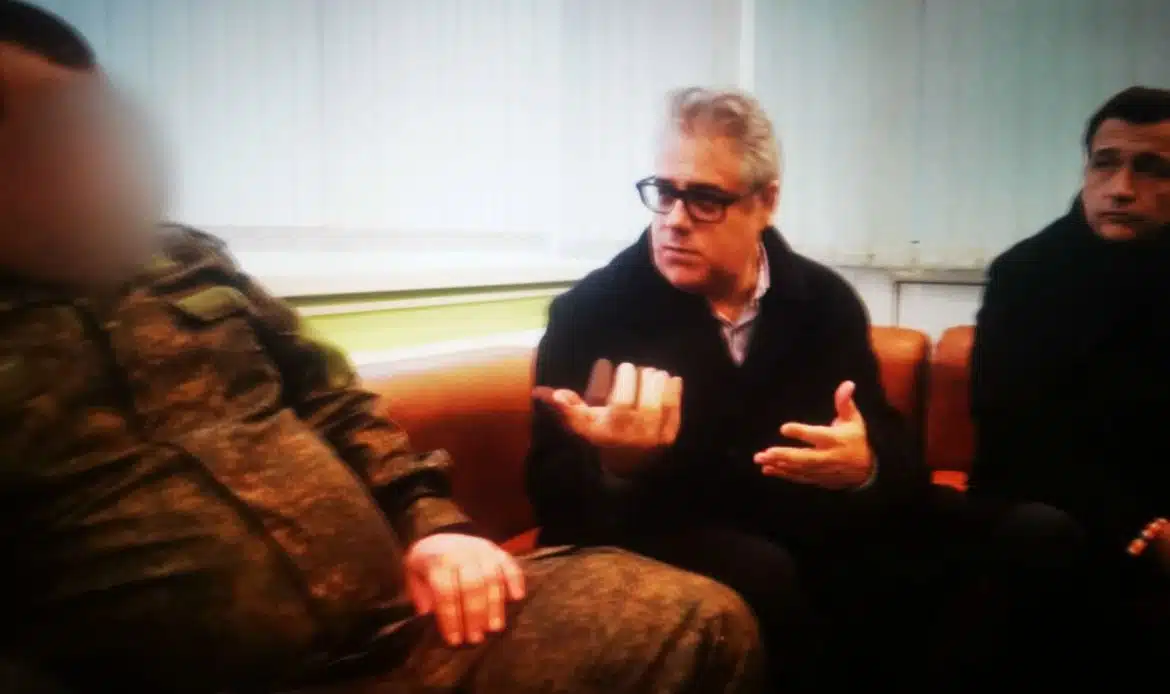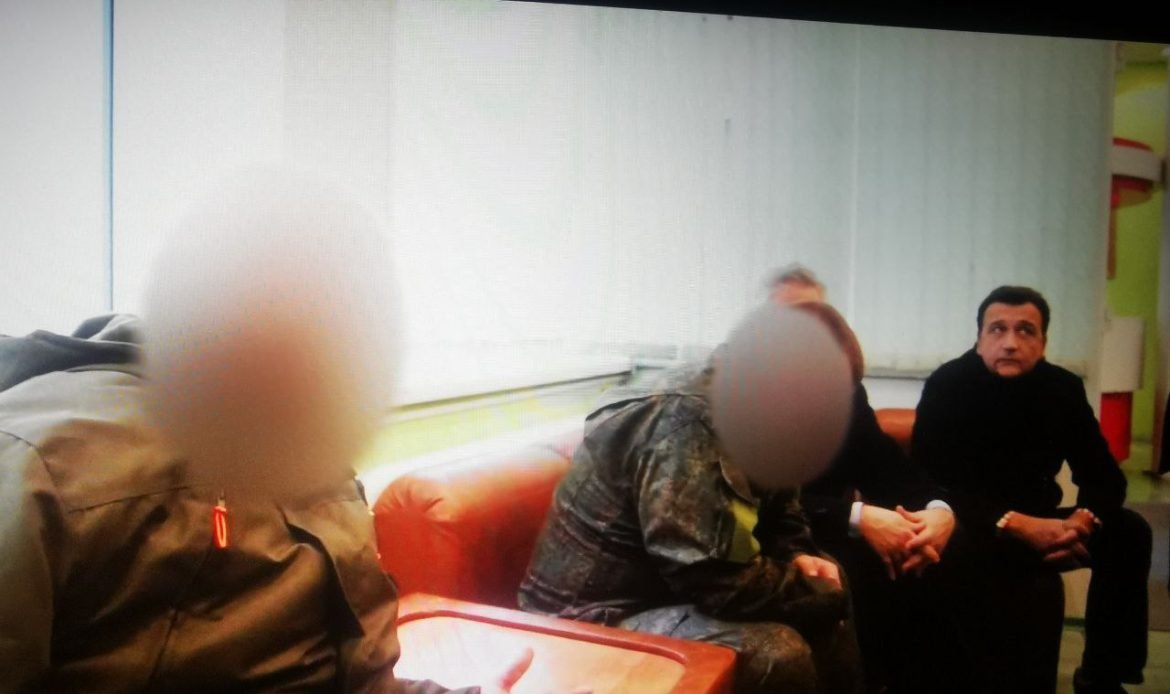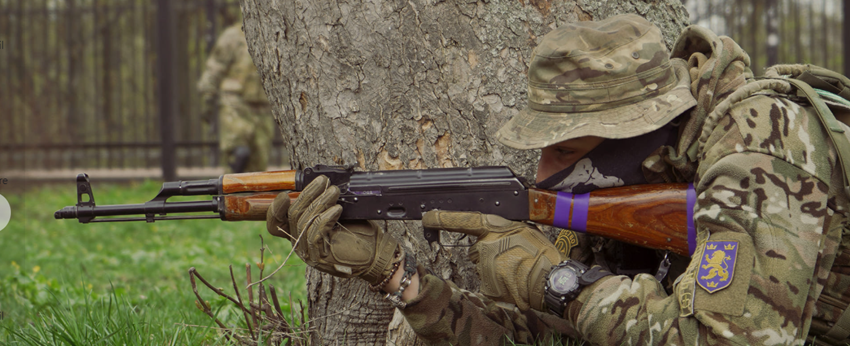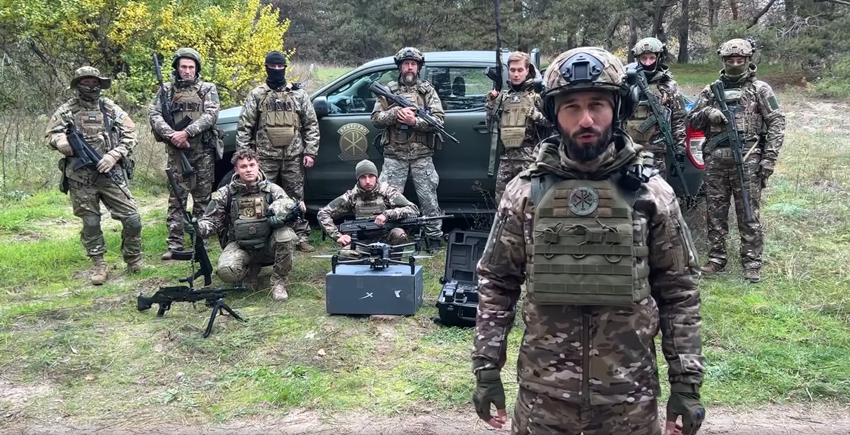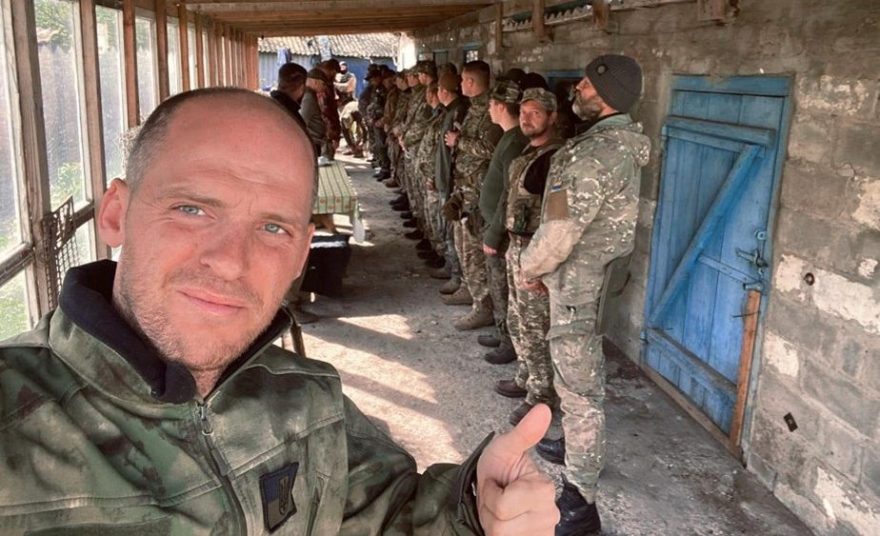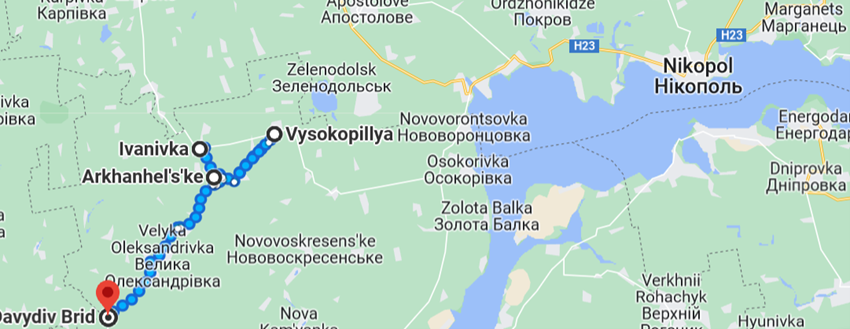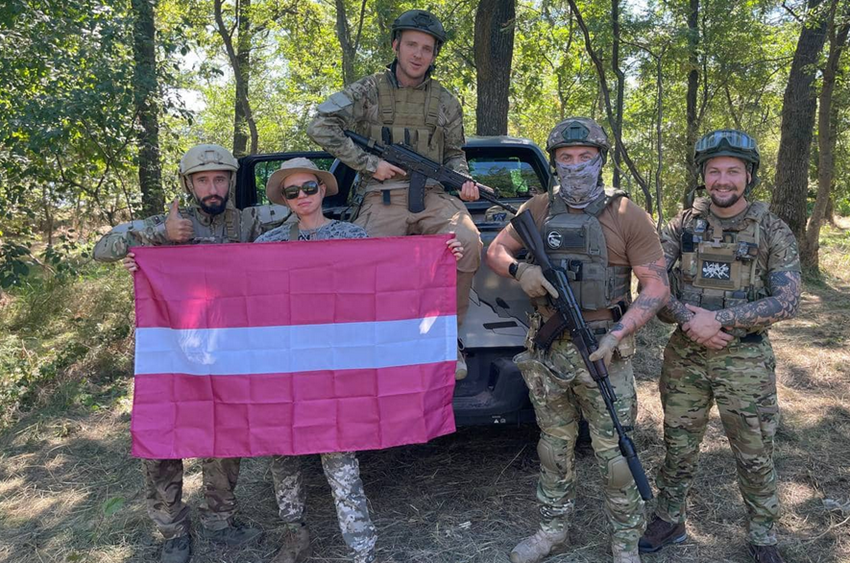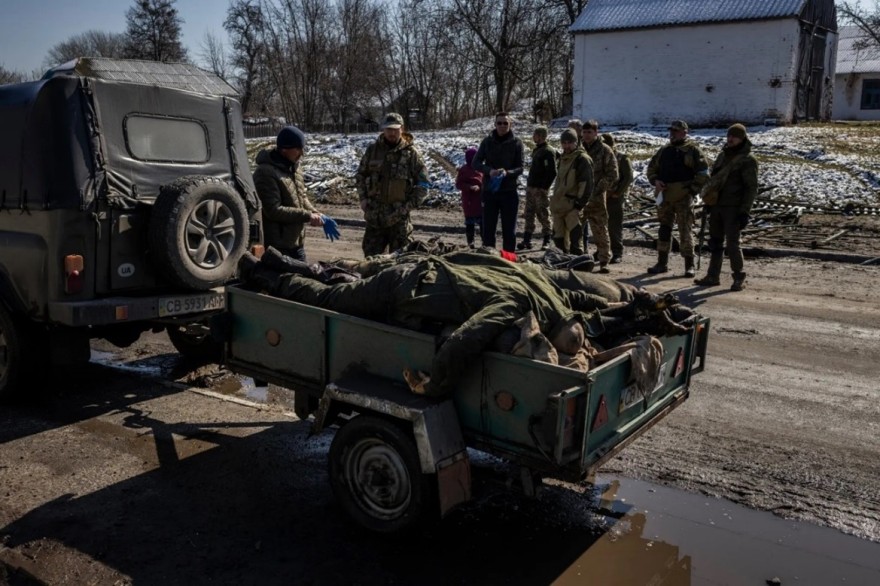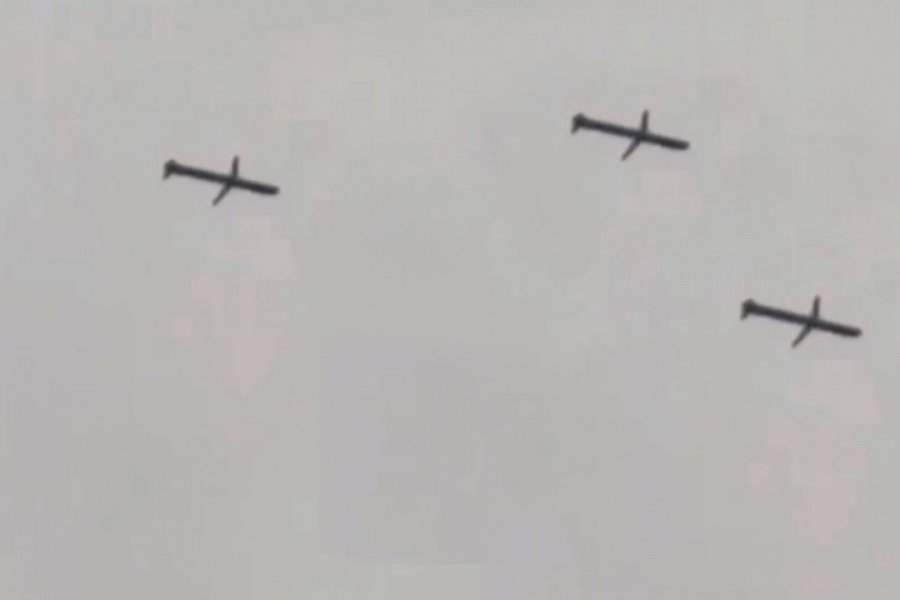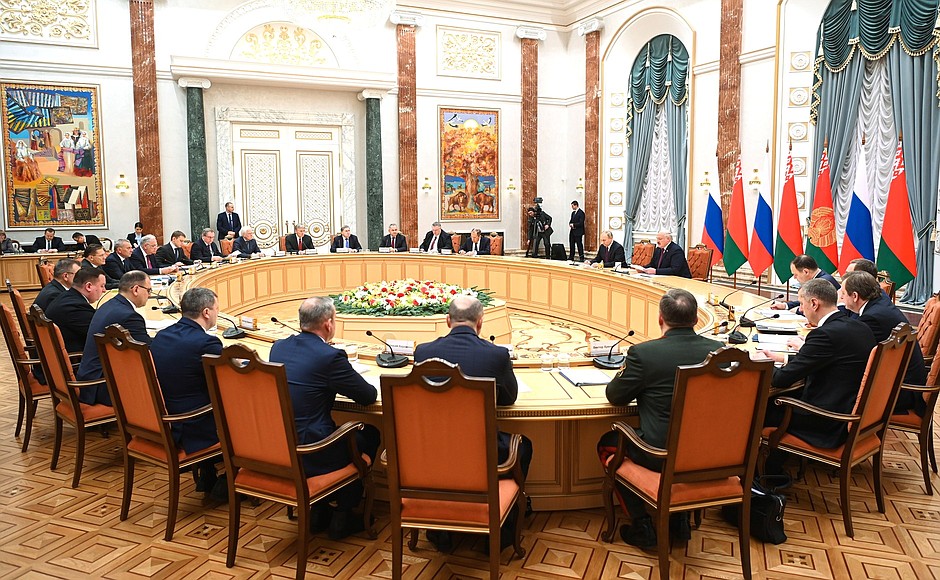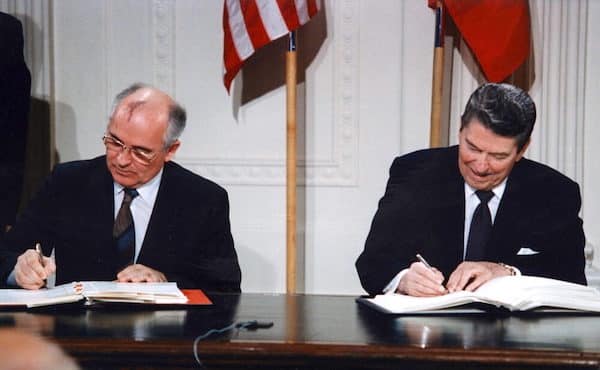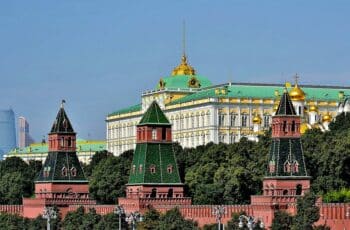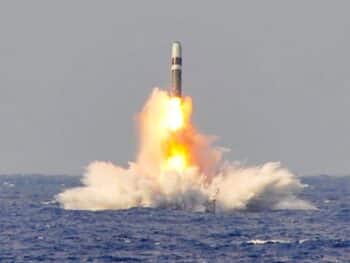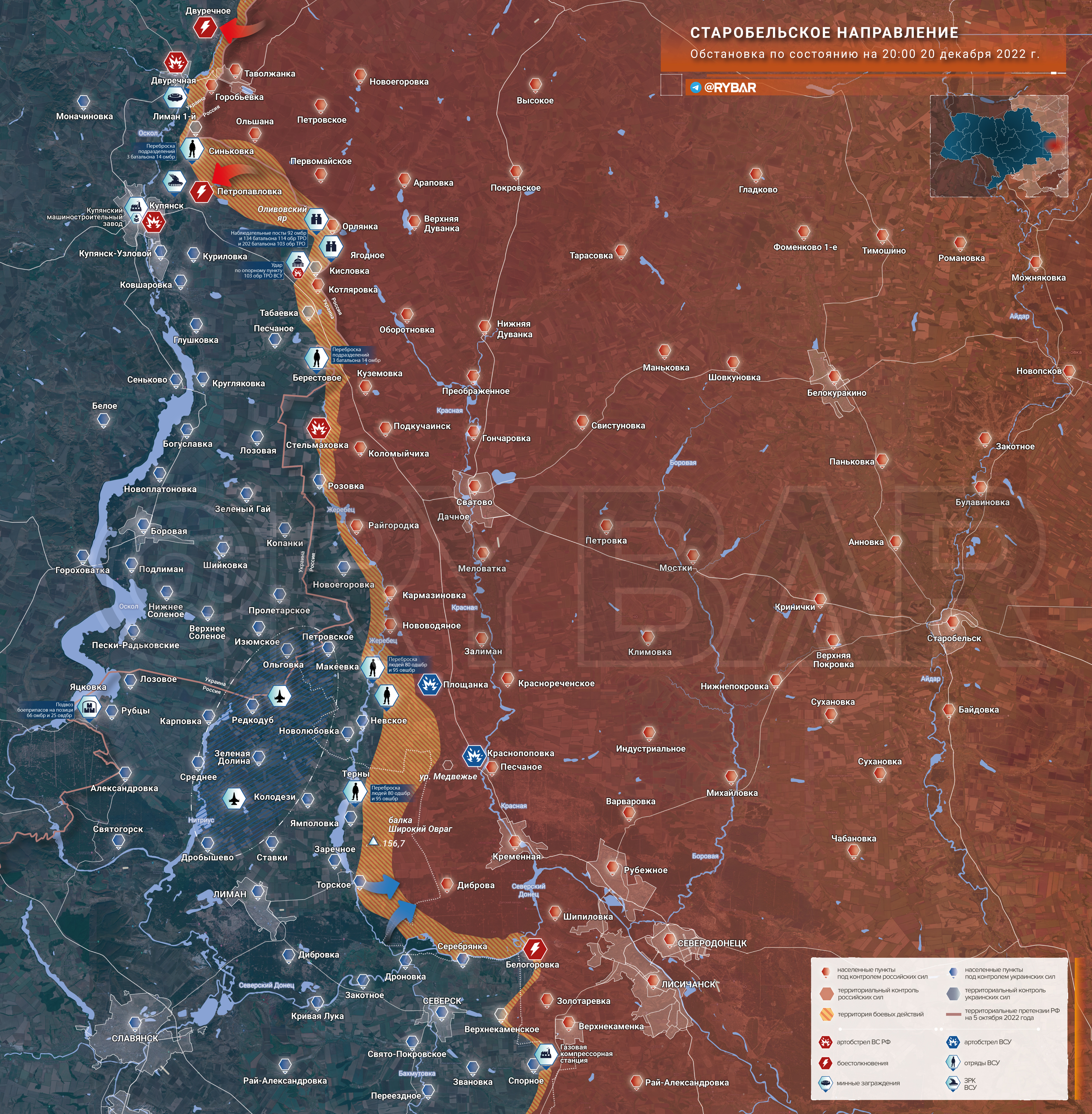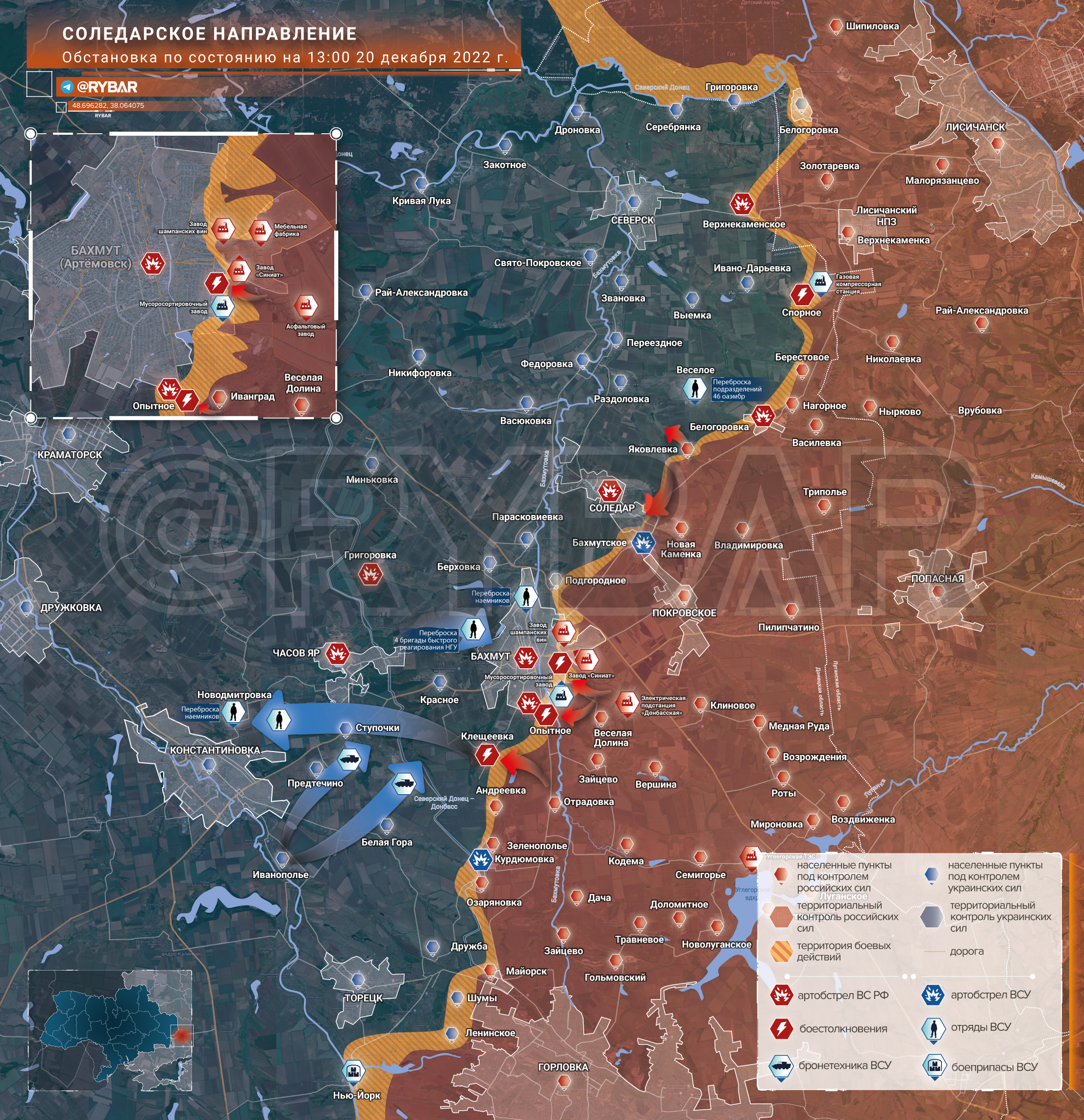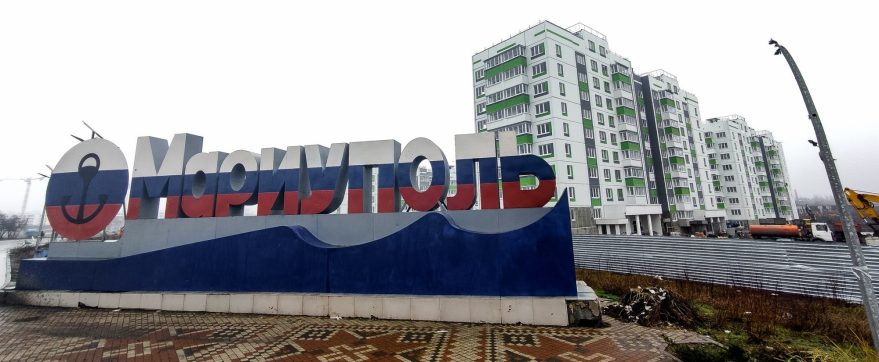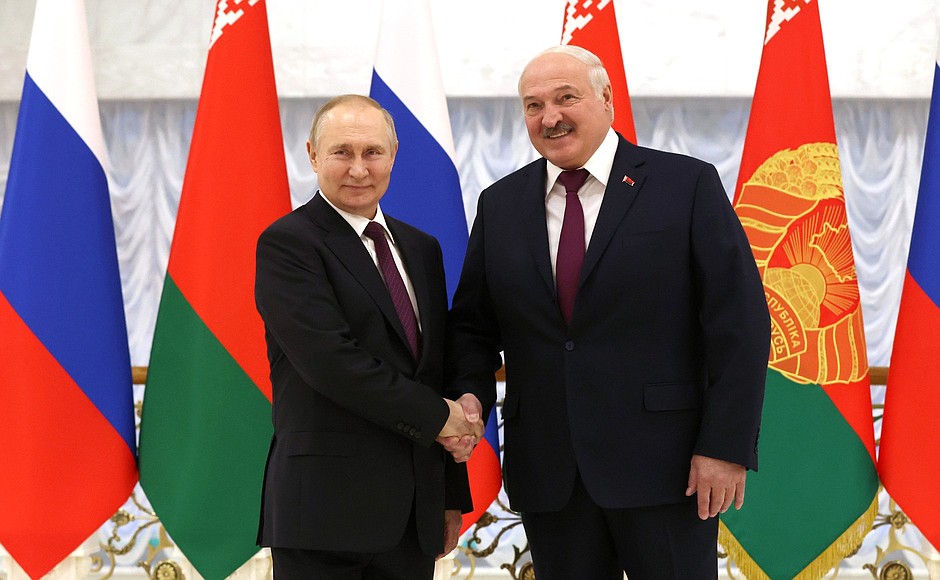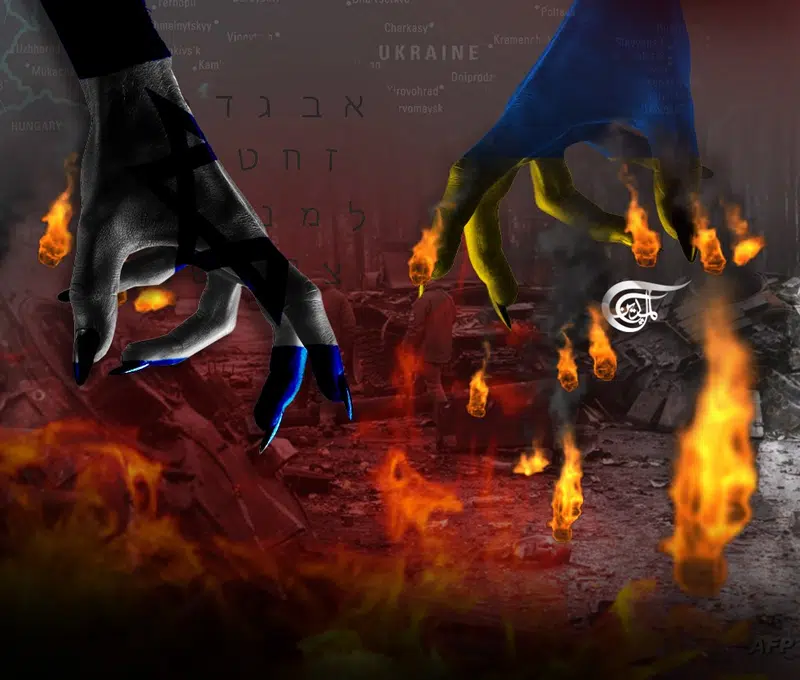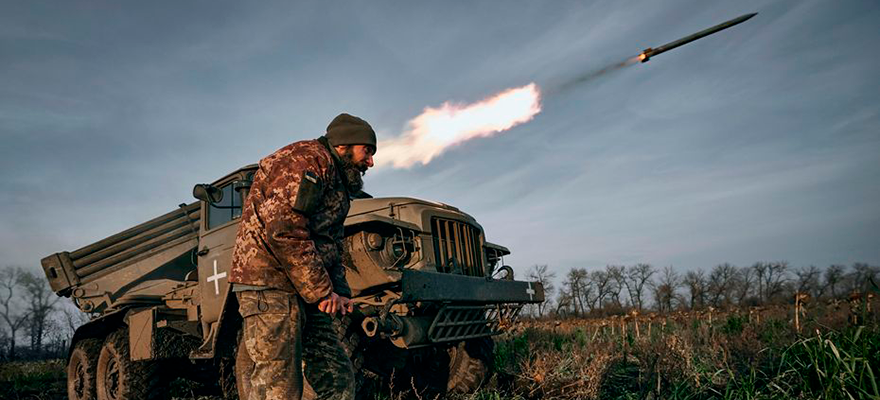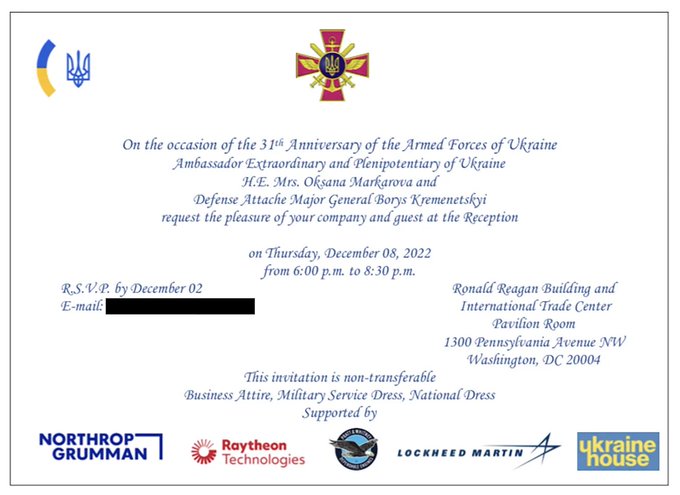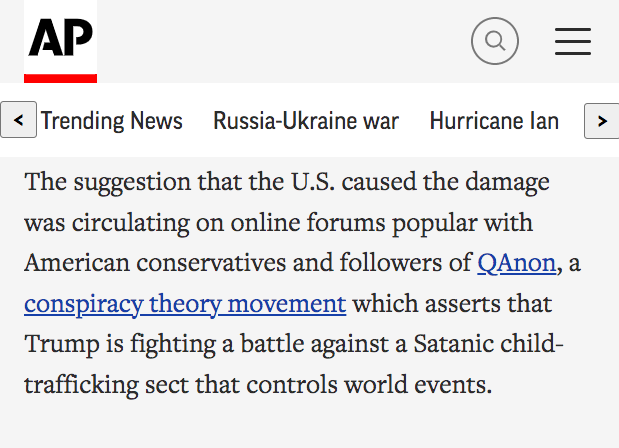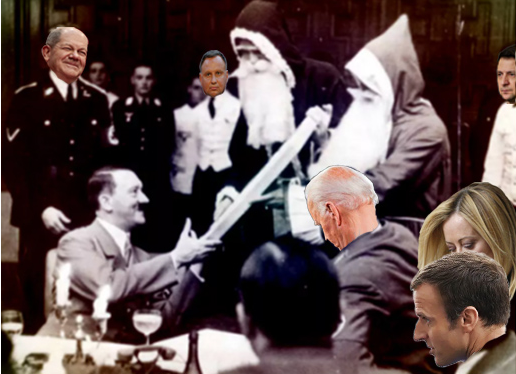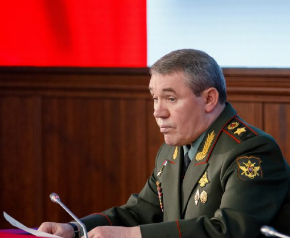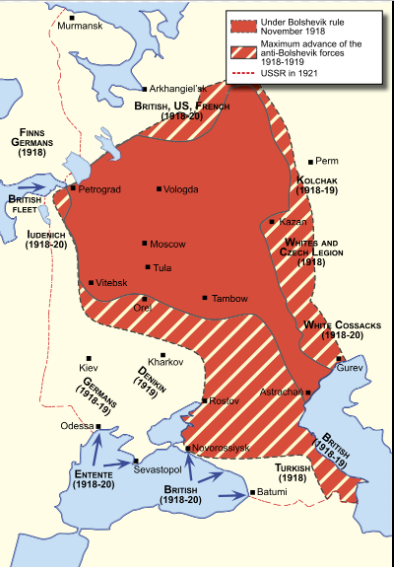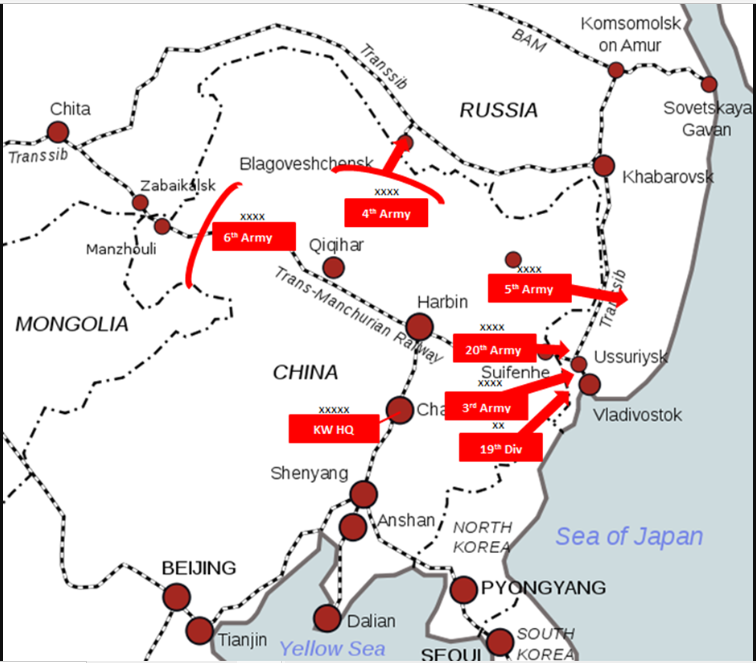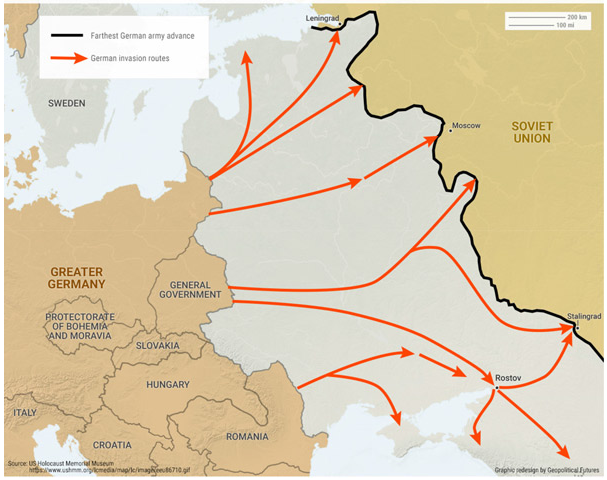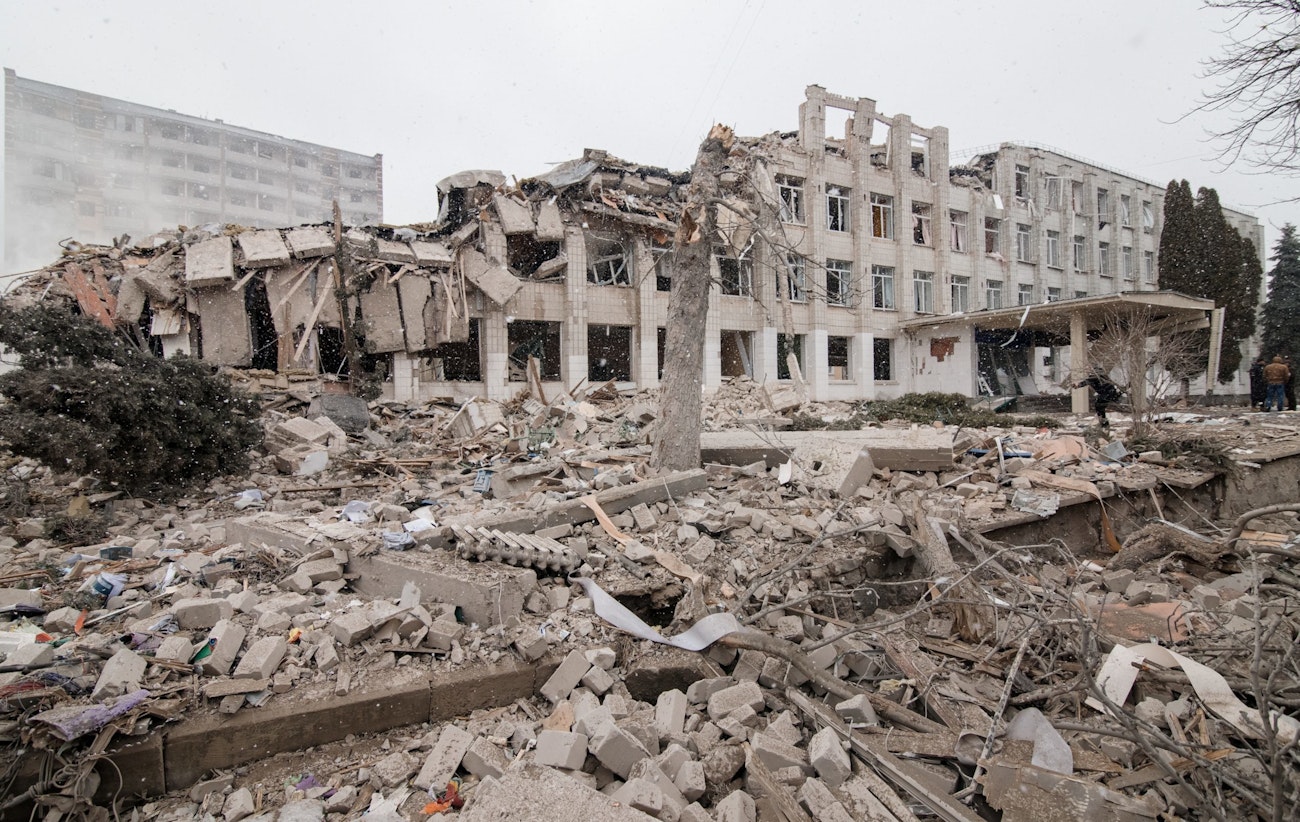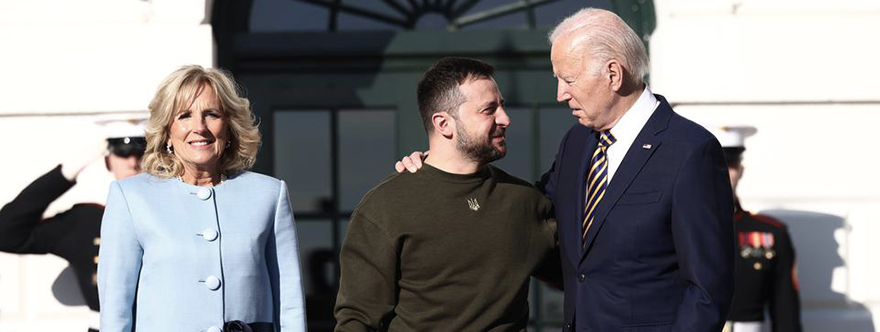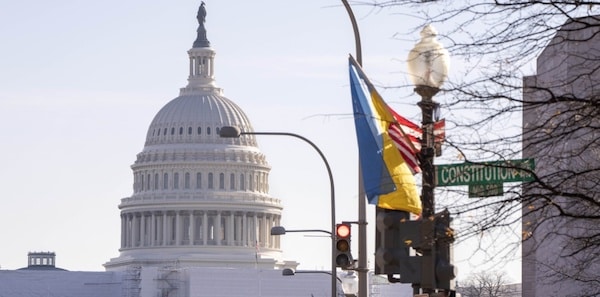POSTED BY @NSANZO ⋅ 12/17/2022
Dmytro Korchynsky's Bratstvo Battalion. Part 3. The war tour: kyiv region
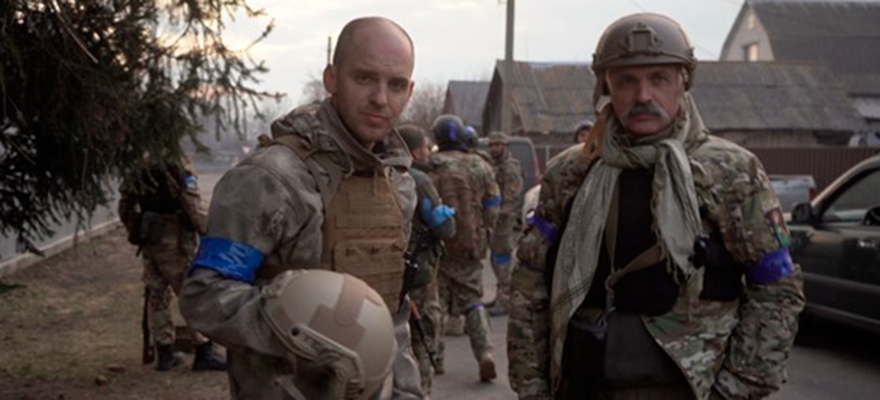
As an example of the action of the many battalions of pro-Ukrainian extremists and fanatics, this third installment reconstructs the warfare of the Bratstvo Battalion during the Russo-Ukrainian war of 2022.
The mobilization and training of the first volunteers
On February 25, 2022, Dmytro Korchynsky broadcasts a video announcing the recruitment of volunteers in kyiv to participate in the defense of Ukraine. In another video from the same day, three of the main militants of the Bratstvo Battalion come out bare-faced, including Oleksiy Serediuk and Vitaly Chorny.
As its main leaders mention in their speeches, the original purpose of the Battalion is “ to carry out active recruitment and training of volunteers, ready to train, who participate in the defense of Kiev ”. In practice, the role of Bratstvo will adapt as the Ukrainian counteroffensive progresses. The process, usual in this type of groups, of demand for funds and material begins in parallel. This demand will be precisely the main element of continuity in the action of public dissemination of information by the group.
On the same day, the 25th, just over twenty volunteers from Bratstvo receive weapons, form units and prepare to carry out military tasks for the defense of kyiv.
Each volunteer undergoes basic military training before moving into combat positions. It includes a phase of theoretical training, with the learning of basic concepts of tactics and strategy (they are seen for this purpose from the age of 26 at the Taras Shevchenko University, which will become a recruitment and training center for Bratstvo); and another practice, handling weapons. In addition to the general instruction of the commanders, given the religious dimension of the Battalion, and its claim to be part of a warrior Church, they also receive teachings from the service chaplain.
The Bratstvo battalion is placed under the overall leadership of the 10th Mountain Assault Brigade of the Ukrainian Armed Forces. During the counteroffensive phase in kyiv, it will follow the 8th Battalion of that Brigade.
The defense and counteroffensive east of kyiv: from the end of February to the first week of April 2022
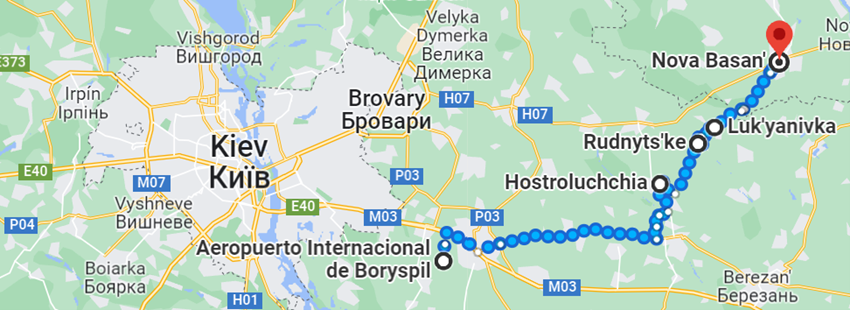
The route of Bratstvo in the Ukrainian counteroffensive in the kyiv region.
In the initial phase, linked to the defense and counteroffensive in the Kiev region, the Bratstvo Battalion assumes a support role for the defense - occupation of positions and control - but also advancing in the counteroffensive, with reconnaissance of terrain, collaboration in the offensive actions and " cleaning " of the recovered towns. Its most qualified task is to carry out actions of strategic reconnaissance of the territory for a more effective deployment of the military forces and obtaining a significant advantage over the Russian forces. The Battalion also participates in the recovery of military material abandoned in its withdrawal by the Russian army.
As a most outstanding fact, as the Ukrainian offensive advances, Bratstvo will gain weight in the management of the artillery action of the Ukrainian forces.
The route of Bratstvo in the Ukrainian counteroffensive in the kyiv region.
At the Borispol airport
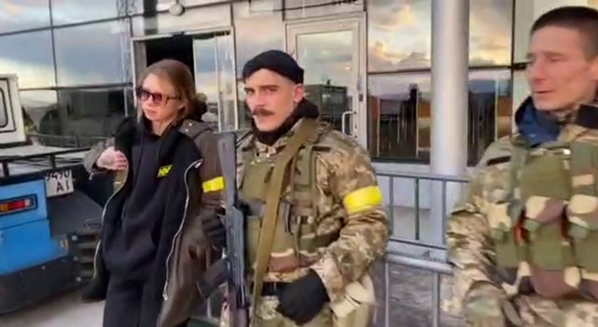
Experienced Battalion members are quickly dispatched to defense and combat positions. About thirty militants, including Zaverukha and several foreign volunteers, both Western and Belarusian, position themselves on February 28 at the Borispol international airport. There they are in the first weeks of March (at least until the 8th).
The reconquest of the eastern kyiv region
On March 12, the presence of Bratstvo soldiers was recorded at checkpoints in the town of Hostroluchchya, in the Brovary district. According to the Battalion, constant battles are fought in this area and its forces help repel various attacks in the area. On the 17th they successfully defend the access positions to kyiv.
As of March 18, more offensive actions are observed. On March 18, for example, a video posted on the Internet shows the actions of the 8th Battalion of the 10th Mountain Brigade around the village of Rudnytske, with the probable presence of some members of Bratstvo. The video shows the attempt to approach the town, accompanied by artillery action with the support of drones. Among the buildings attacked by Ukrainian forces is the town's school.
On the 18th it is reported that a Russian cruise missile hits the center of Baryshivka where the forces of the Bratstvo Battalion were stationed, 15 kilometers southwest of Rudnytske. Despite the destruction of the facilities, there are no deaths.
The action on the 18th anticipates the role that Bratstvo will play in the counter-offensive that will make it possible to recover various towns in the basically rural territory of the Kiev region that lies between Borispol and Nova Basan, the latter already in the Chernigov oblast . The action will be facilitated by the strong logistical and supply problems of the Russian forces and by the subsequent decision of the Russian Federation to progressively withdraw its forces from the kyiv region in the framework of the Russo-Ukrainian negotiations that culminate in the Istanbul summit. , but also before the manifest infeasibility of quickly taking or besieging the capital.
lukyanovka
According to some people in the area, Russian forces arrive on March 2 in the neighboring villages of Lukyanovka and Rudnytske. They end up stationed in those positions, probably due to the Ukrainian destruction of the bridges at Rusaniv and Selyshche, which prevented a further advance towards kyiv. The Russian soldiers requisition the houses and take over the telephones, although not always strictly (some of the interviewees kept theirs). Access to the houses is permanently open to Russian forces.
In Lukyanovka, residents are prohibited from using the roads and paths, and are therefore forced to stay in their homes. In Rudnystke , on the other hand, one day in four the population was allowed to leave their houses. In this town, their local representative was able to organize a delivery system for humanitarian products, protected by Russian forces. According to local sources (blatantly anti-Russian), the troops occasionally shared their rations with the minors.
On March 24, in the context of the progressive withdrawal of the Russian army towards the Novo Basan-Bobrovytsya line, the first important objective of the counteroffensive in the area northeast of Borispol is Lukyanovka.
Coming from Lukashi (a town besieged but never occupied by Russian forces), the assault on Lukyanovka took place between 12 noon and 5 p.m. that day. It is accompanied by an artillery attack similar to the one observed on the 18th in Rudnytske, although more specifically directed in this case against all the positions and equipment of the Russian Federation in the town. In a credible way, in this attack Bratstvo affirms that it begins to assume the direction and correction of the fire of the squad of mortars of the Ukrainian army. These aspects will mark the role of Bratstvo in subsequent actions, both in the Kharkov area and in the Kherson-Zaporizhia area.
According to the analyzed and verified sources, the assault on Lukyanovka, where there were more than five tanks and other Russian armored vehicles, is being carried out by different Ukrainian units, supported by two tanks and two BMPs, a reconnaissance drone system, and artillery. Dozens of fighters from the 8th Battalion of the 10th Mountain Assault Brigade are taking part in the action , who will follow all these assaults from Lukashi to Rudnytske. In addition to this unit of the regular army, there is the presence of Azov fighters (integrated into the National Guard) and volunteers from Yaroslav Hodunok's Borispol Territorial Defense. Among the volunteer battalions, in addition to the Bratstvo, members of the DFTG Svoboda Battalion are present on the ground. There is also Dmytro Linko, in command of the recovered Revenge Battalion, thus separated from the Bratstvo group. The presence on the ground of the American mercenary James Vasquez seems equally accredited.
A total of 120 Ukrainian soldiers are taking part in the assault and are facing, according to them, around 170 members of the Russian forces (BTG 30th Mechanized Brigade). The armored attack, in which Belarusian volunteers from Bratstvo are participating, is supported by a tank and two BMPs. According to a photo report by Levko Stek and Maryan Kushmir for RFERL , three Russian tanks heading towards the Ukrainian tank entering Lukyanovka end up turning back, one of them getting stuck in the mud (one of the structural problems of the Russian cavalry in their move towards Kiev) after going off the road. The rest suffers the attacks of the Ukrainian artillery.
A note from Bratstvo dated the 24th, at 20:04, states that during the attack a convoy of armored vehicles coming from Peremogy tried to help the Russian troops in Lukyanovka but, damaged by Ukrainian artillery, had to return to their point of departure. According to this same note, during the night of the 24th, the Russian forces tried to assault the town with tanks and BMPs, but were forced to withdraw. Lukyanovka remained under Russian artillery fire during the night of the 24th/25th. Although probably already far away, the artillery fire could still be heard in the village on the 27th of March.
The available information only shows the detention of a Russian soldier in Lukyanovka. There are no reliable sources on the number of casualties, although a local resident interviewed by RFERL mentions around 40 Russian casualties, a figure that would be repeated by all Ukrainian sources. According to this resident, the combat was hard, with powerful fire from artillery, tanks and machine guns. Ukrainian forces faced heavy resistance. Although different sources later mention the presence of dead soldiers in the Lukyanovka fields, no images are available in this regard.
In the Ukrainian ranks, there is evidence of the death of two Azov fighters -Denys Kotenko ( Skipper ) and Serhii Zaikovsky ( Deimos )-, which occurred during the tank battle observed in the access to the town. The two were soldiers of the anti-tank platoon of the kyiv regiment of the Azov Regiment. A third member ( Slavyan ) was seriously injured. In the Russian counterattack, Dmytro Kirichenko, from the Revancha Battalion, was killed.
The capture of Lukyanovka forces the Russian forces to withdraw and establish the defensive line around the H07 road. It facilitates, on the other hand, the Ukrainian advance towards Nova Basan, some 19 km away by road, in the center of the positions of the Russian forces to the east of kyiv. According to War Mapper, the situation at the end of March already showed the great weakness of the Russian positions in this region, with hardly any strong control in the area near Nova Basan.

Unlike other village seizures, numerous videos show the seizure of Lukyanovka, many of them with clear propaganda purposes, such as those relating to the presence of Vita Zaverukha or the role of the Belarusian Ivanov by Bratstvo, although there are also videos of Azov and the American James Vasquez, all of them with a proven presence in the town on March 24.
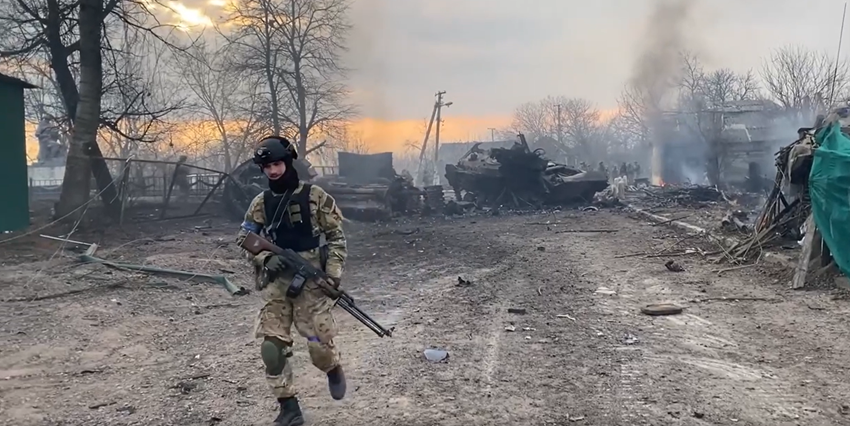
rudnytske
According to the Russian soldier detained in Lukyanovka, part of the Russian forces in the town is retreating in the direction of Rudnytske. The sources already mentioned in that town indicate that, on the night of the 24th, “ the town became the center of hell. The ground trembled from gunshots and explosions. Continuous roar and explosions. The shooting continued throughout the night… It seemed that all the shells fell towards us, a curtain of earth rose outside the window again and again…they suffered a lot of fear that night ”. This testimony indicates that the Ukrainian artillery action against Rudnytske is directly related to the aforementioned Russian attacks on Lukyanovka.
According to these sources, during the morning of the 25th the Russian forces leave Rudnytske. “ Of the 60 units of military equipment that entered in early March, seven tanks and four armored personnel carriers were withdrawing from the town .”
The Ukrainian command takes note on the 27th of the withdrawal of the Federation army from the Rudnytske-Lukyanovka area. General information at that time showed the intention of the Russian forces in the area to group around Nova Basan.
On March 28, citing a small resistance by way of a scripted plot, Ukrainian forces enter Rudnytske. A unit from Bratstvo, led by Serediuk and Zaverukha, is among those forces. Also present are forces from Svoboda , from Revancha and from the Gonor group, to which Serhiy Sternenko belongs, and from the Georgian Legion . " Members of the International Territorial Defense Legion " were also reportedly present .
The euphoria in Bratstvo is evident: “ What can we say about this? ”, the Battalion asks on its YouTube page: “ If God is in our favor, then who is against us… ”.
Nova Basan
The end of the counteroffensive by Bratstvo and the other Ukrainian forces east of the kyiv region is Nova Basan, already in Chernigov Oblast.
On March 31, social media is flooded with images of captured Russian equipment along the route to the town. The photographer's collection of photos of the Bratstvo Battalion that follows its journey in the kyiv region shows the presence of its members in all events associated with the Ukrainian advance.
The direct attack on Nova Bosan also took place on the 31st. That same day , civilian sources confirmed the rapid departure of the Russian forces from the city, an exit that could have already begun during the night. The Bratstvo Battalion is already present in the city. This is confirmed by both their own videos and images included in an article by Carlotta Gall in The New York Times , published on April 4, including a photo in which Vita Zaverukha is seen delivering humanitarian aid to the population.
Carlotta Gall reproduces the Ukrainian account transmitted by Bratstvo and other Ukrainian sources about the capture of Nova Basan. She points out that the Russian exit was part of a planned withdrawal announced by Moscow a week ago, but which ended in " a chaotic and bloody withdrawal after a fierce tank battle last Thursday [March 31] ." Gall refers to an attack captured in a video from Bratstvo, published on April 5, accompanied by this comment: “ Heroic and skilful work of the Ukrainian tank against the Russian column. Burning enemy equipment with a fleeing crew is a must! ”.
The video shows the attack of a camouflaged tank that has the retreating Russian armored and infantry column in sight and fires at it, as well as against other positions of the Russian forces, while the Ukrainian artillery attacks in parallel against other positions and equipment . In the video you can see the destruction of several BTR-82As, some of them on fire, with the crew lying on the ground.
As described by Robert Spangle, on esquire.com , also heavily supported by material from Bratstvo"Ukrainian fighters tried a new tactic: instead of attacking enemy positions, they ambushed a column retreating through the center of the city. It began with an artillery attack on a well-supplied Russian ammunition truck as it entered an intersection, followed by tank cannon fire from a concealed position against the column. It is noted that the Russian fighters panicked; they trapped several vehicles on steep or muddy terrain, and were quickly abandoned by their crews. Other vehicles scattered, only to get stuck on side streets. On the outskirts of Nova Basan, two Russian armored personnel carriers that survived the ambush were met with cannon fire. Three crew members managed to get only a few meters away from their vehicle.”.
Serediuk is quoted in Gall's article mentioning the Ukrainian army's intention to pursue the retreating army: “The military command made a very smart decision, firstly to make their retreat a chaotic flight and secondly to cut off their escape route ” . According to Serediuk, “ The battle at Nova Basan was chaotic, as the Russians had to fight their way out and the Ukrainians tried to cut off their escape route. In the battle, a Russian armored vehicle crashed into a row of shops and another went off the road . According to a witness quoted by Gall, "The bombardment began at six in the morning and lasted until seven at night, without respite ."
By April 7, the kyiv region no longer had a Russian force presence.
https://slavyangrad.es/2022/12/17/26198/#more-26198
Second casualties in an eight year war
POSTED BY @NSANZO ⋅ 12/16/2022 ⋅
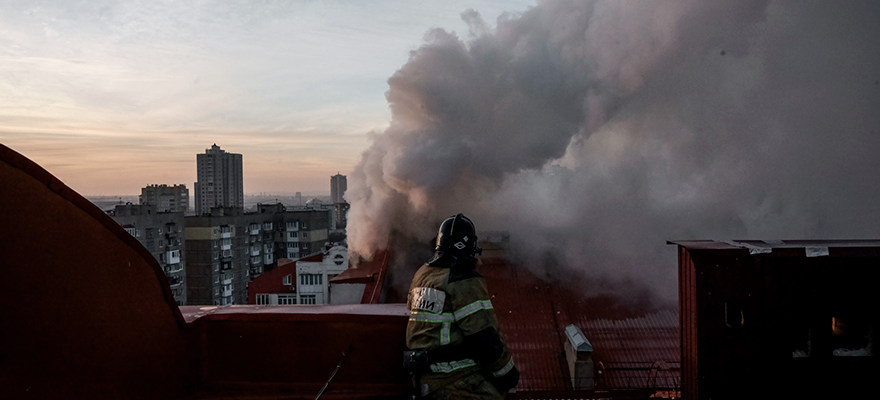
As usual, the month of December has been accompanied by numerous events in which the most outstanding personalities of the year are highlighted for their contribution to the different events. Lists of personalities of the year are also common. In a 2022 marked by the war between Russia and Ukraine and by the great involvement of Western countries, it was foreseeable that the title of man of the year from media such as Timefell to Volodymyr Zelensky, the president who came to power with the promise of a commitment to a peace that he did not seek before 2022 or since February 24. This week also saw the delivery of the European Parliament's Sakharov Prize, which has honored the Ukrainian people for their resilience in the face of foreign aggression, an announcement accompanied by the promise of more financing - actually more debt that Ukraine will not be able to pay - and a greater commitment to help the population overcome a catastrophic winter.
A common feature of all these events is the desire to highlight two ideas: the resistance of the Ukrainian people and the unity of the country. To this we must add the exaltation of the will to fight shown by the army, something that no one should have doubted, since, rearmed and tested during eight years of trench warfare and accompanied by almost a decade of hateful ideological work to everything Russian, including the people of Donbass, it was clear that, for the troops, the fight would be to the end. It is also common to all these acts and daily praise that Ukraine receives, even more common than the announcements of more arms deliveries and financing, that this idea of strength and unity ignores the situation of the last almost nine years. The casualty figures given by Ukraine and repeated en masse by the entire Western press, they begin on February 24 and are limited to the population and troops fighting on the side defended by the West. In this way, not only the more than 14,000 people who died in the first eight years of the war in Ukraine are erased from all reality, but also the entire civilian population that has died, been wounded and that has suffered and continues to suffer the hardships of the war. across the front.
The idea of Russian aggression that kyiv managed to install in the world press throughout the eight years of war in Donbass has been extremely useful for both the authorities and the media in presenting Ukraine as an innocent victim fighting for democracy against the tyranny of “Putin's war”. The beginning of the Russian military intervention implied an immediate wave of solidarity and compassion with the Ukrainian population, a support that this population never showed to those who, on the other side of the front, suffered and continue to suffer the same fate. The population of Donbass did not choose war in 2014 in the same way that the population of Ukraine did not in 2022.
The rejection of a government that had come to power by an irregular method and that had overthrown the democratically elected president meant in Donetsk and Lugansk the repetition of a scenario that had been experienced in Maidan and that Ukraine defines as the revolution of dignity . But the occupation of administrative buildings in Donetsk and Lugansk did not receive Western support, rather the protest was demonized from its inception, long before the armed group that came from Russia captured, led by Strelkov , the Slavyansk police station. At the moment when the situation called for diplomacy, the Turchinov-Yatseniuk government responded with a dialogue that only included pro-Maidan groups and personalities and by inventing an anti-terrorist operation.to justify the use of the army within the national territory, he tried to use military force to solve a political problem. A situation that was repeated systematically throughout the seven years of the Minsk process, the one that now even those who most defended it admit that it was a tool with which Ukraine managed to buy time to rearm.
In all this time, in which kyiv artificially maintained a low-intensity trench warfare with the aim of maintaining tension and seeking Russian concessions but without excessively increasing violence so as not to cause a Russian intervention, the population of Donbass has been the great ignored. Ukraine not only refused to grant amnesty to those who had participated in the war, but also sought and continues to seek to punish those who have fought on the front lines during this time. They were not Russian soldiers who for eight winters suffered the cold of the steppe in the trenches, but rather young and not so young locals who, in many cases, saw no professional opportunity other than risking their lives. Ukraine, France and Germany, which have pledged to resume the banking system in Donbass, they never kept their word and the state of war has meant for what was one of the most important regions of Ukraine, a deteriorated economic situation in which the army was one of the few relatively safe ways to guarantee a salary at the end of the month. To the deficiencies that the state of war necessarily implies, we must add the physical destruction and the lack of water, electricity or communications, which has been a common factor in the front areas since 2014.
Since last February, and especially since the end of May, when Ukraine no longer saw any danger in attacking the center of Donetsk -since it would not provoke a particularly harsh Russian reaction-, it is the population of the most important city of Donbass who suffers from all these shortcomings. The Ukrainian-controlled water supply situation in the north of the region is particularly serious and people have been seen collecting water directly from the Kalmius River. Since the summer, the urban area of Donetsk - whose population exceeds one million - lives with a water supply of just a few hours, three times a week, with schedules that cannot always be met. The lack of water also implies the absence of heating. All this without its resilience, which lasts more than eight years, not ten months, be highlighted in major international forums or show solidarity with a people that seems to not exist. That unity of the people that is repeated so much today is limited only to those who are on the correct side of the front despite the fact that the situation of the civilian population is not only similar, but is sometimes even more serious.
This is the case of security, which in cities like Donetsk, until a few months ago a relatively protected city and in whose center there are no military installations, is not guaranteed at any time and in any place. Using Grad rockets, notoriously indiscriminate, Ukraine has shown in the last week that there is no time when the population can go out to carry out their daily tasks or go to work without feeling in danger. Ukraine has attacked at lunchtime, at the time of returning from work or, like yesterday, first thing in the morning.
As even the Western media, accustomed to ignoring shelling on the wrong side of the front, reported, “pro-Russian” or “Russian puppet governments” yesterday denounced the worst shelling of central Donetsk since 2014. Over the past seven Over the years, Ukraine has beaten, sometimes mercilessly, areas on the outskirts of the city and destroyed nearby towns such as Spartak, but the center of Donbass' main city had been left relatively untouched. The list of streets attacked yesterday by the 40 Ukrainian Grad rockets -Artyom, Universitetskaya or the pier- make it clear, for any connoisseur of the city, that they were residential and office districts. The university, a boiler room or simple apartment buildings were damaged in an attack that killed at least one person and injured a dozen.
However, the objective of these indiscriminate and practically daily bombardments since May 29 is not only to kill and destroy, but above all to intimidate. Every Donetsk resident is already aware that there is no place and no time of day when he can feel completely safe. And by firing Grad rockets, which the Russian air defense cannot afford to fight on a daily basis, Ukraine also seeks to undermine the population's confidence in Russia's ability to defend it. After more than six months of indiscriminate shelling and a steady trickle of civilian casualties, it is clear that the only possible defense for the population of Donetsk is to keep the Ukrainian Armed Forces as far away from the city limits. However, even then,
In his article this week in The Washington Post, Max Boot, a professional in seeking more war and more confrontation with Russia, called for Ukraine to be given all the necessary weapons so that it could attack every meter of Russian-occupied Ukrainian land.. Perhaps Western columnists want Ukraine to be able to do in the entire south, in the entire Donbass and in the entire Crimea, what kyiv has been doing in Donetsk for more than six months. It is unlikely that, even in that case, the population on the wrong side of the front would receive any sympathy from those who show solidarity with the Ukrainian people by sending more weapons to kill and demanding that there can only be a peace negotiation on Ukrainian terms, i.e. , after the surrender of Russia and that population that has been resisting the Ukrainian military, economic, political and diplomatic aggression for eight years, which began seven years before the Russian troops crossed the border in the direction of kyiv.
https://slavyangrad.es/2022/12/16/26189/
Google Translator
****************
Ukraine - What Its Military Leadership Says
The Economist has interviewed the three Ukrainian leaders who manage the war in Ukraine. It summarizes them in an interpretive writeup. I will use that to extract the important points.
Volodymyr Zelensky and his generals talk to The Economist (Paywalled)
The writeup is of course full of propaganda but one can still glean some information from it.
The first interview (transcript) was with Volodymyr Zelensky, Ukraine's president, who is saying nothing new that would be of interest:
“People do not want to compromise on territory,” he says, warning that allowing the conflict to be “frozen” with any Ukrainian land in Russian hands would simply embolden Mr Putin. “And that is why it is very important…to go to our borders from 1991.”
Zelensky wants Crimea back. Good luck achieving that impossibility one might say.
The second interview is with General Valery Zaluzhny, Commander-in-Chief of the Armed Forces of Ukraine. The third interview is with Colonel-General Oleksandr Syrsky, the head of Ukraine’s ground forces.
All three men emphasised that the outcome of the war hinges on the next few months. They are convinced that Russia is readying another big offensive, to begin as soon as January.
The author writes that "Ukraine enjoyed a triumphant autumn." One wonders how many thousand Ukrainian soldiers have died for that triumph that was in reality a well controlled Russian retreat to shorten its frontlines.
But neither General Zaluzhny nor General Syrsky sounds triumphant. One reason is the escalating air war. Russia has been pounding Ukraine’s power stations and grid with drones and missiles almost every week since October, causing long and frequent blackouts. Though Russia is running short of precision-guided missiles, in recent weeks it is thought to have offered Iran fighter jets and helicopters in exchange for thousands of drones and, perhaps, ballistic missiles.
Yes, we have known since March 2 that Russia is running out of precision-guided missiles. It has since used only 4,500 of those.
“It seems to me we are on the edge,” warns General Zaluzhny. More big attacks could completely disable the grid. “That is when soldiers’ wives and children start freezing,” he says. “What kind of mood will the fighters be in? Without water, light and heat, can we talk about preparing reserves to keep fighting?"
When it is cold and dark morale indeed becomes a problem. It is not the only one.
A second challenge is the fighting currently under way in Donbas, most notably around the town of Bakhmut. General Syrsky, who arrives at the interview in eastern Ukraine in fatigues, his face puffy from sleep deprivation, says that Russia’s tactics there have changed under the command of Sergei Surovikin, who took charge in October. The Wagner group, a mercenary outfit that is better equipped than Russia’s regular army, fights in the first echelon. Troops from the Russian republic of Chechnya and other regulars are in the rear. But whereas these forces once fought separately, today they co-operate in detachments of 900 soldiers or more, moving largely on foot.
Bakhmut is not an especially strategic location. Although it lies on the road to Slovyansk and Kramatorsk, two biggish cities (see map), Ukraine has several more defensive lines to fall back on in that direction. What is more, Russia lacks the manpower to exploit a breakthrough. The point of its relentless onslaught on Bakhmut, the generals believe, is to pin down or “fix” Ukrainian units so that they cannot be used to bolster offensives in Luhansk province to the north. “Now the enemy is trying to seize the initiative from us,” says General Syrsky. “He is trying to force us to go completely on the defensive.”
If Bakhmut is not a strategic location why is the Ukrainian army sending more and more troops into it? Russia is using Bakhmut not only to “fix” Ukrainian units. It is using it to eliminate them with up to 500 Ukrainian soldiers killed or wounded per day. The real fixing operation is happening elsewhere.
Ukraine also faces a renewed threat from Belarus, which began big military exercises in the summer and more recently updated its draft register. On December 3rd Sergei Shoigu, Russia’s defence minister, visited Minsk, the Belarusian capital, to discuss military co-operation. Western officials say that Belarus has probably given too much material support to Russian units to enter the fray itself, but the aim of this activity is probably to fix Ukrainian forces in the north, in case Kyiv is attacked again, and so prevent them from being used in any new offensive.
General Zaluzhny has a quite realistic view on what is coming:
“Russian mobilisation has worked,” says General Zaluzhny. “A tsar tells them to go to war, and they go to war.” General Syrsky agrees: “The enemy shouldn’t be discounted. They are not weak…and they have very great potential in terms of manpower.” He gives the example of how Russian recruits, equipped only with small arms, successfully slowed down Ukrainian attacks in Kreminna and Svatove in Luhansk province—though the autumn mud helped. Mobilisation has also allowed Russia to rotate its forces on and off the front lines more frequently, he says, allowing them to rest and recuperate. “In this regard, they have an advantage.”
But the main reason Russia has dragooned so many young men, the generals believe, is to go back on the offensive for the first time since its bid to overrun Donbas fizzled out in the summer. “Just as in [the second world war]…somewhere beyond the Urals they are preparing new resources,” says General Zaluzhny, referring to the Soviet decision to move the defence industry east, beyond the range of Nazi bombers. “They are 100% being prepared.” A major Russian attack could come “in February, at best in March and at worst at the end of January”, he says. And it could come anywhere, he warns: in Donbas, where Mr Putin is eager to capture the remainder of Donetsk province; in the south, towards the city of Dnipro; even towards Kyiv itself. In fact a fresh assault on the capital is inevitable, he reckons: “I have no doubt they will have another go at Kyiv.”
The general is building and holding back reserves which is problematic for the front lines:
The temptation is to send in reserves. A wiser strategy is to hold them back.
...
“May the soldiers in the trenches forgive me,” says General Zaluzhny. “It’s more important to focus on the accumulation of resources right now for the more protracted and heavier battles that may begin next year.”
Ukraine has enough men under arms—more than 700,000 in uniform, in one form or another, of whom more than 200,000 are trained for combat. But materiel is in short supply. Ammunition is crucial, says General Syrsky. “Artillery plays a decisive role in this war,” he notes. “Therefore, everything really depends on the amount of supplies, and this determines the success of the battle in many cases.” General Zaluzhny, who is raising a new army corps, reels off a wishlist. “I know that I can beat this enemy,” he says. “But I need resources. I need 300 tanks, 600-700 IFVs [infantry fighting vehicles], 500 Howitzers.” The incremental arsenal he is seeking is bigger than the total armoured forces of most European armies.
Does Zaluzhny really believe that he could get that force? I don't think so.
The Economist points out that donors of weapons have run out of pretty much everything:
On December 6th America’s Congress agreed in principle to let the Pentagon buy 864,000 rounds of 155mm artillery shells, more than 12,000 GPS-guided Excalibur shells and 106,000 GPS-guided GMLRS rockets for HIMARS—theoretically enough to sustain Ukraine’s most intense rate of fire for five months non-stop. But this will be produced over a number of years, not in time for a spring offensive.
Russia has similar problems. It will run out of “fully serviceable” munitions early next year, says an American official, forcing it to use badly maintained stocks and suppliers like North Korea. Its shell shortages are “critical”, said Admiral Tony Radakin, Britain’s defence chief, on September 14th.
The last part is of course as valid as the claim that Russia is 'running out of missiles'.
But even while lacking armored forces and ammunition Ukraine still dreams of big attacks:
“With this kind of resource I can’t conduct new big operations, even though we are working on one right now,” says General Zaluzhny.
The writer discusses various options where Ukraine could attack but finds that it does not really have a good one. The big victory over Russia will not be coming:
In private, however, Ukrainian and Western officials admit there may be other outcomes. “We can and should take a lot more territory,” General Zaluzhny insists. But he obliquely acknowledges the possibility that Russian advances might prove stronger than expected, or Ukrainian ones weaker, by saying, “It is not yet time to appeal to Ukrainian soldiers in the way that Mannerheim appealed to Finnish soldiers.” He is referring to a speech which Finland’s top general delivered to troops in 1940 after a harsh peace deal which ceded land to the Soviet Union.
So how many soldiers will still have to die before Zaluzhny is willing to give his Mannerheim speech (vid)? He does not say.
He will probably have to hold his speech sooner than he thinks because the Ukrainian economy has broken down. GDP decreased by 33% this year and, as attacks on the electrical net continue, it will shrink by another 5 or 10% next year. Inflation is above 20%, unemployment above 30%. The big metal and mining industries had to shut down as they depend on uninterrupted electricity supplies. Meanwhile donors are unwilling to hand to Ukraine the budget it claims to need.
It seems possible that the pending bankruptcy of Ukraine may indeed end the war earlier than any military action.
Posted by b on December 15, 2022 at 17:24 UTC | Permalink
https://www.moonofalabama.org/2022/12/u ... .html#more
*******************
"Paying reparations to Ukraine". 12/16/2022
December 16, 11:07

In the morning, the Aerospace Forces of the Russian Federation, on Vatutin's birthday, continued to "pay reparations" to Ukraine. Launched under 100 different cruise missiles, which achieved dozens of hits throughout the territory of Ukraine.
At 11 a.m., the Russian Aerospace Forces were turned off - Kyiv, Kharkov, Dnepropetrovsk, Poltava, Krivoy Rog, Odessa, Kremenchug, etc.
Several TPPs and other infrastructure facilities were hit.
In addition to the missing light, at least 6 regions are experiencing serious disruptions to cellular communications, the Internet, and water supply. In four or five regions there are serious problems with the work of the railways, the enemy is trying to switch to diesel locomotives, but delays in the movement of trains are already inevitable.
The Zelensky gang is now probably thinking about declaring that they shot down 80% or 90% of all launched missiles, especially against the backdrop of a wave of blackouts.
In general, it can be noted that the Russian Aerospace Forces continue to methodically implement the strategy launched by a series of strikes on October 10-12, and the consequences of this strategy are quite visible and tangible.
Broadcast of hostilities in Ukraine, including strikes on the energy structure, as usual in Telegram https://t.me/boris_rozhin - if you are interested, subscribe
https://colonelcassad.livejournal.com/8034739.html
Google Translator
*******************
U.S. Government Media Outlet Directs Air Strikes on Crimea
Posted by INTERNATIONALIST 360° on DECEMBER 16, 2022
Strategic Culture Foundation EditorialRFE

Surely a negotiated settlement to the conflict in Ukraine and the wider security concerns of Russia should be a priority. But regrettably, Washington and its European and Kiev minions are incapable of such diplomacy.
The Radio Free Europe outlet this week blatantly published satellite images of Russian military bases in Crimea and openly advocated for the Kiev regime to launch strikes. The reality is even more sobering and grim. It would not be the Kiev regime carrying out such strikes, but rather U.S., British and other NATO special forces acting as the brains and stealthy hands of the regime.
Moscow has already inveighed against NATO as being a direct participant in hostilities in Ukraine. The RFE report corroborates Russia’s claims. It is self-admission by the United States of being a party to the conflict.
The satellite images were provided by a private U.S. company called Planet Labs which has a history of working closely with the Pentagon. The images included an airbase at Dzhankoy which is described as a main logistics hub. Naval sites at Sevastopol were also listed in detail as well as purported ammunition tunnels in the surrounding mountains. Other targets included anti-aircraft positions near Feodosia on the Crimean Peninsula. From Moscow’s viewpoint, the peninsula is the sovereign territory of the Russian Federation. Yet here we have the U.S. government’s media mouthpiece giving out the coordinates and calling for air strikes on “prime targets”.
RFE is wholly owned by the U.S. government and it has a long and tawdry history of acting as a CIA conduit in Eastern Europe during the height of the Cold War. For the publication to publish targets for military attack and to advocate for such action is tantamount to Washington openly declaring itself to be director of war operations by the Kiev regime.
This role by Washington and its NATO allies has long been surmised since the conflict in Ukraine erupted in February this year. Indeed for the eight years since the coup in Kiev in 2014, the United States and its NATO partners have been weaponizing and prepping the anti-Russian regime for war, as former German Chancellor Angela Merkel recently admitted.
But since hostilities flared over the past 10 months, the United States, Britain, Poland and other NATO members have been actively involved in providing not just weapons, but training, logistics and intelligence for attacking Russian forces. It is believed that American and British advisers have been directing Ukrainian air strikes at the Zaporozhye Nuclear Power Plant, as well as more recently on air bases deep inside Russian territory. The assassination of over a dozen senior Russian military commanders in the battlefields is also thought to be as a result of close targeting information provided by U.S. intelligence.
The sinking of the Moskva, the Russian navy’s flag ship in the Black Sea Fleet, with the loss of many personnel onboard, is another incident that points to NATO’s overarching involvement in the pursuit of this war.
At the end of October it is believed that American and British special forces were involved in a daring drone attack on Crimea. That incident led to Moscow temporarily cancelling the shipping arrangement for grain exports from the Black Sea.
All this apparent participation in the conflict has been brazenly stonewalled by Washington and its NATO allies who steadfastly claim to be not a party to the conflict. Just this week, the Biden administration announced that it was planning to supply Patriot missiles to Ukraine which Moscow condemned as another serious escalation. The Pentagon rebuffed Russian concerns and maintained that the “United States is not at war with Russia, and we do not seek conflict.”
Such blithe denials of responsibility in the conflict are either delusional or bare-faced lies. The fact is the United States and its NATO allies are at war in Ukraine against Russia. The arsenal of weapons and financial support for the Kiev regime is ensuring that the conflict is prolonged and near-impossible to halt. The United States and the European Union are bankrolling a self-declared NeoNazi regime to the tune of $100 billion in both military and financial aid.
The weapons being supplied to Ukraine have become incrementally more sophisticated and longer-range, including the HIMARS, ATACMS, IRIS-T and NASAMS artillery and anti-aircraft systems. The announcement of Patriot deliveries is a further escalation. These advanced systems necessarily mean that American, British, German and other NATO troops are on the ground in Ukraine firing weapons at Russian targets. It’s inconceivable that Ukrainian conscripts could operate these systems without NATO commanders and advisers, if not actual triggermen.
Besides, too, there have been admissions by U.S. and British military sources that their special forces are operating covertly in Ukraine.
All of this contradicts previous vows by U.S. President Joe Biden to not deploy American forces or ballistic weapons in Ukraine because that could unleash World War Three. Biden has been lying through his teeth. Which is hardly surprising. American political leaders have been habitually lying about NATO aggression towards Russia for decades.
Washington, London, Berlin and so on are playing a contemptible game of gaslighting. It is evident they are involved in fueling a war on Russia’s doorstep and it is evident that the objective for the war is the ultimate geopolitical prize of instigating regime change in Moscow. Russian President Vladimir Putin has on several occasions succinctly deprecated this Western imperialist agenda.
On the other hand, however, the Western opponents project an air of innocence, claiming against all the evidence that they are “not at war”.
The duplicitous dynamic is comparable to the boiling-frog scenario, as one commentator aptly put it recently. The slow, gradual shift of hostility is aimed at dissembling what is otherwise obviously malign intent.
The insidious game of gaslighting can often be difficult to uncover. That’s what makes it a particularly sinister ruse. It’s a cloaked dagger.
But in the case of the United States and NATO in Ukraine, the game is long past over as to what is really going on – that is, the calculated aggression towards Russia. That aggression has been seeded since the end of the Second World War. The defeat of Nazi aggression was followed by the succession of NATO as the manifest machinery of Western imperialism.
The historic aggression against Russia has culminated in the Kiev regime and its NATO-backed war. That war was a low-intensity campaign for eight years until its fully-fledged form this year.
When a U.S. government-owned media outlet is publishing satellite images of aviation and naval bases in Crimea and openly defining those sites as “prime targets” then we surely know that the conflict has broken through consciousness to the level of public admission. In short, it’s official.
Russia has warned that it will view U.S. and NATO batteries in Ukraine as legitimate targets. What happens when American, British, Canadian, German, Polish and other NATO soldiers start going back in bodybags?
Surely a negotiated settlement to the conflict in Ukraine and the wider security concerns of Russia should be a priority. But regrettably, Washington and its European and Kiev minions are incapable of such diplomacy.
That’s why it seems to be a dawning realization in Moscow that the war in Ukraine must be finished decisively by military means. There is no point trying to negotiate with liars and deluded knaves. That’s been tried already to no avail. The Kiev regime must be eradicated once and for all.
The United States and NATO are all the while threatening a dangerous escalation. But Russia has to finish this war on its terms.
https://libya360.wordpress.com/2022/12/ ... on-crimea/
DPR: The Number of Civilian Victims of Bombing Has Quadrupled Since Kiev Began Using Western Weapons
Posted by INTERNATIONALIST 360° on DECEMBER 15, 2022
Christelle Néant
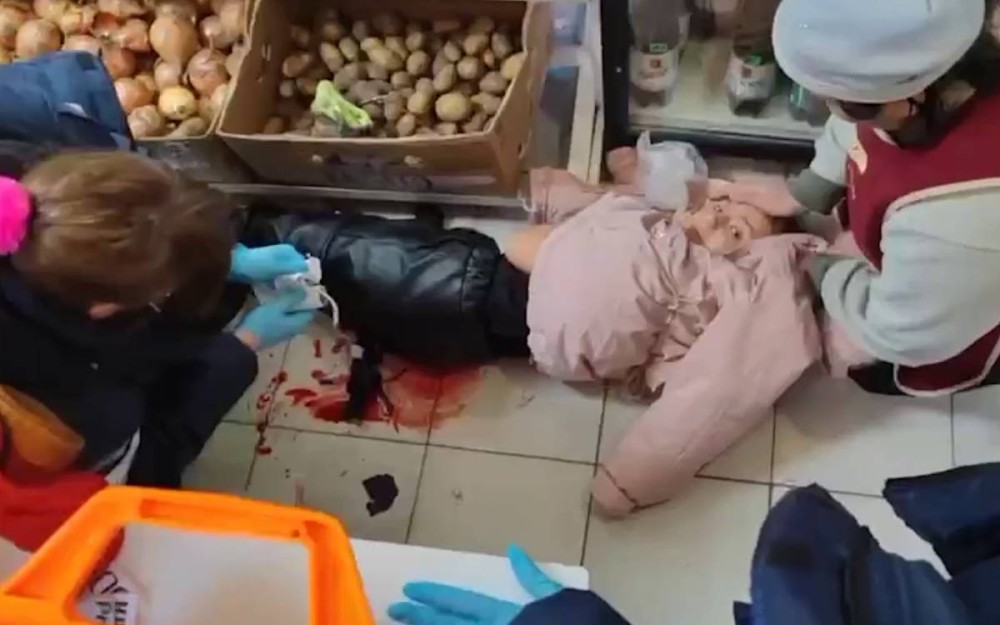
On 14 December 2022, the DPR (Donetsk People’s Republic) organised a conference on Ukraine’s use of Western weapons against civilians and civilian infrastructure in the Donbass, at which pieces of Western weapons found at the bombed sites were shown and it was announced that since Kiev has been using these weapons, the number of civilian casualties has quadrupled.
Representatives of the JCCC (Joint Monitoring and Coordination Centre for War Crimes in Ukraine), and the DPR Human Rights Ombudsman, Daria Morozova, were present at the conference.
Experts from the DPR CCCC showed several pieces of 155 mm shells, Himars rockets and Harm missiles, which were found in places shelled by the Ukrainian army, where these Western weapons caused civilian casualties. They also showed the damage done by petal mines, spread by thousands on the territory of the DPR by the Ukrainian army.
Attention: shocking photos for some:
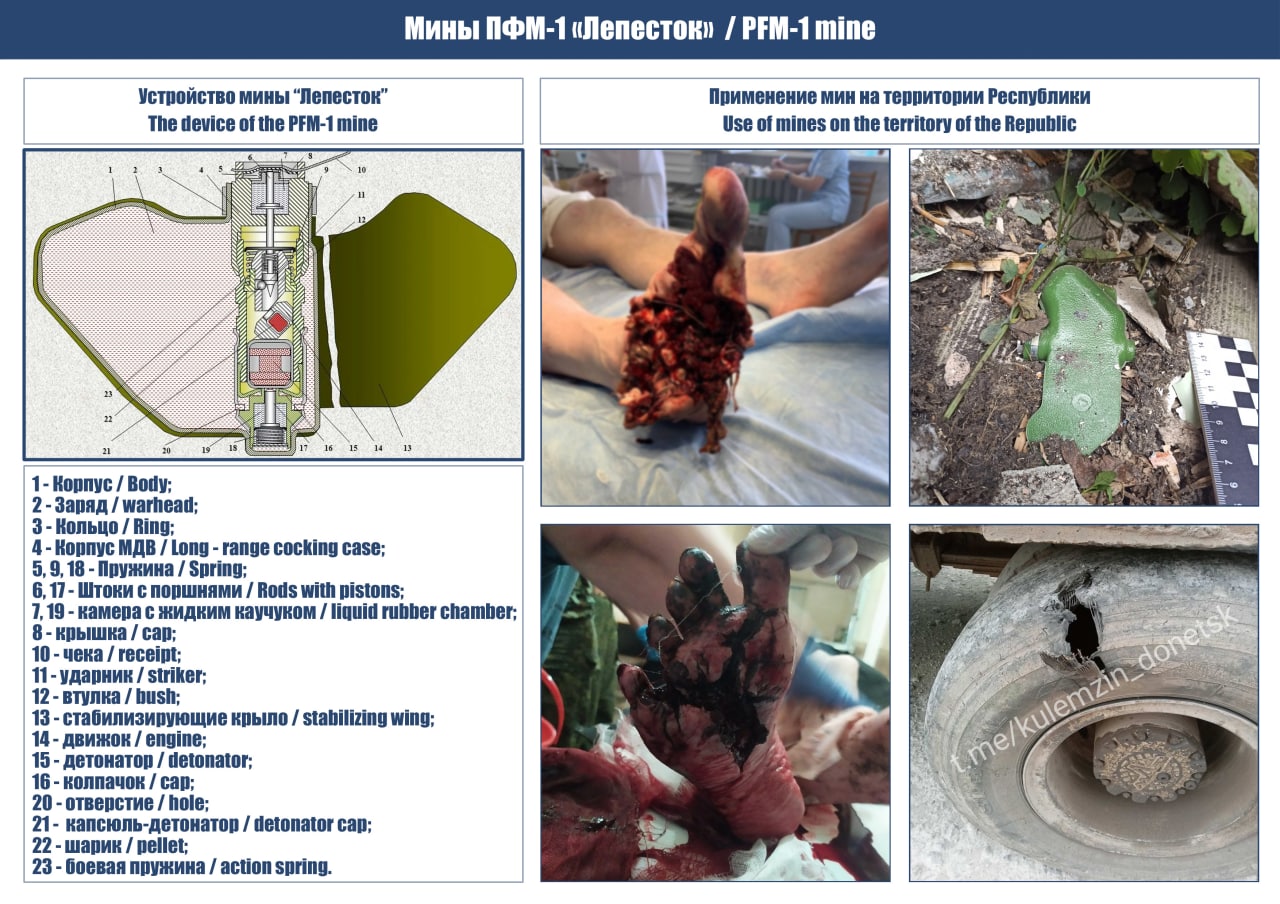
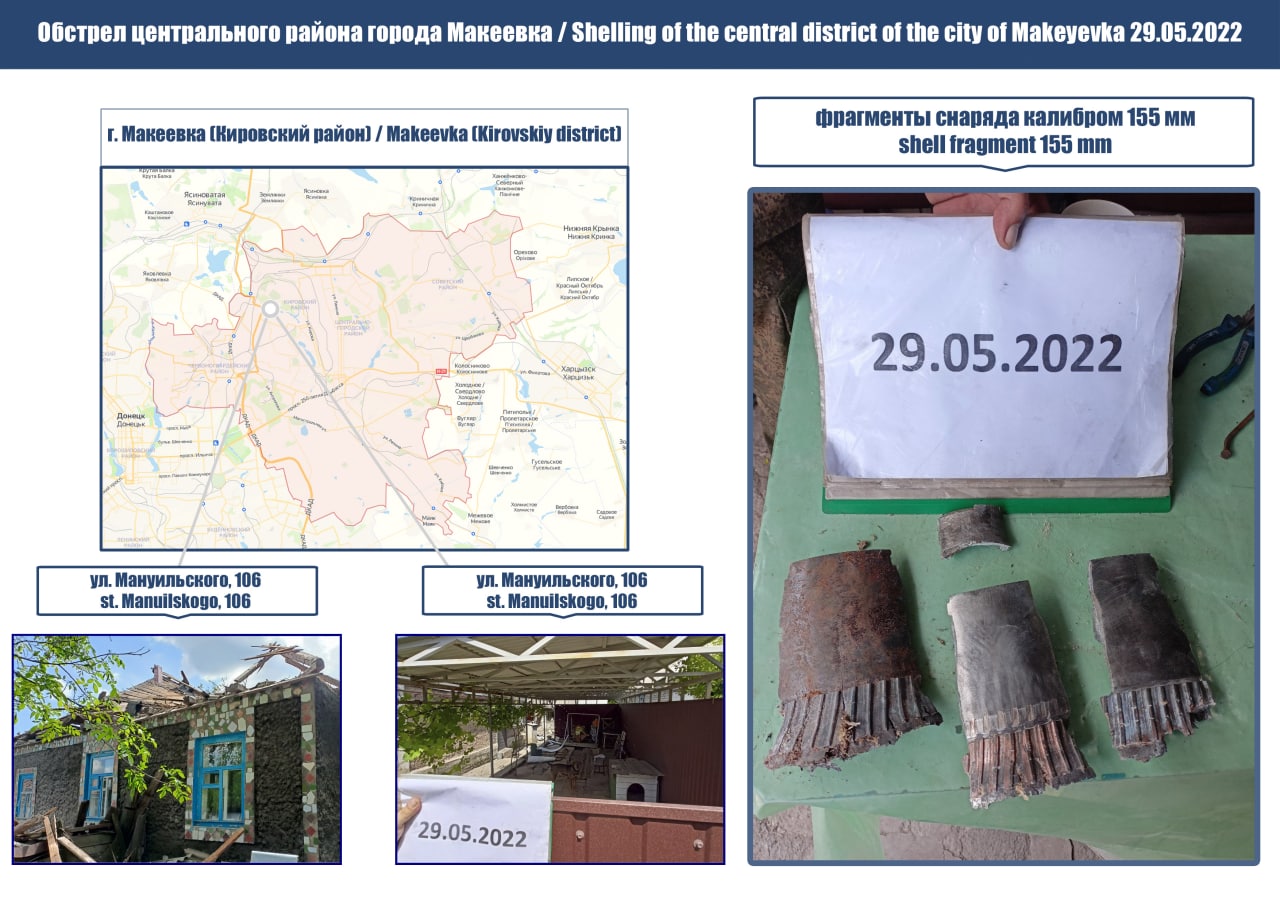



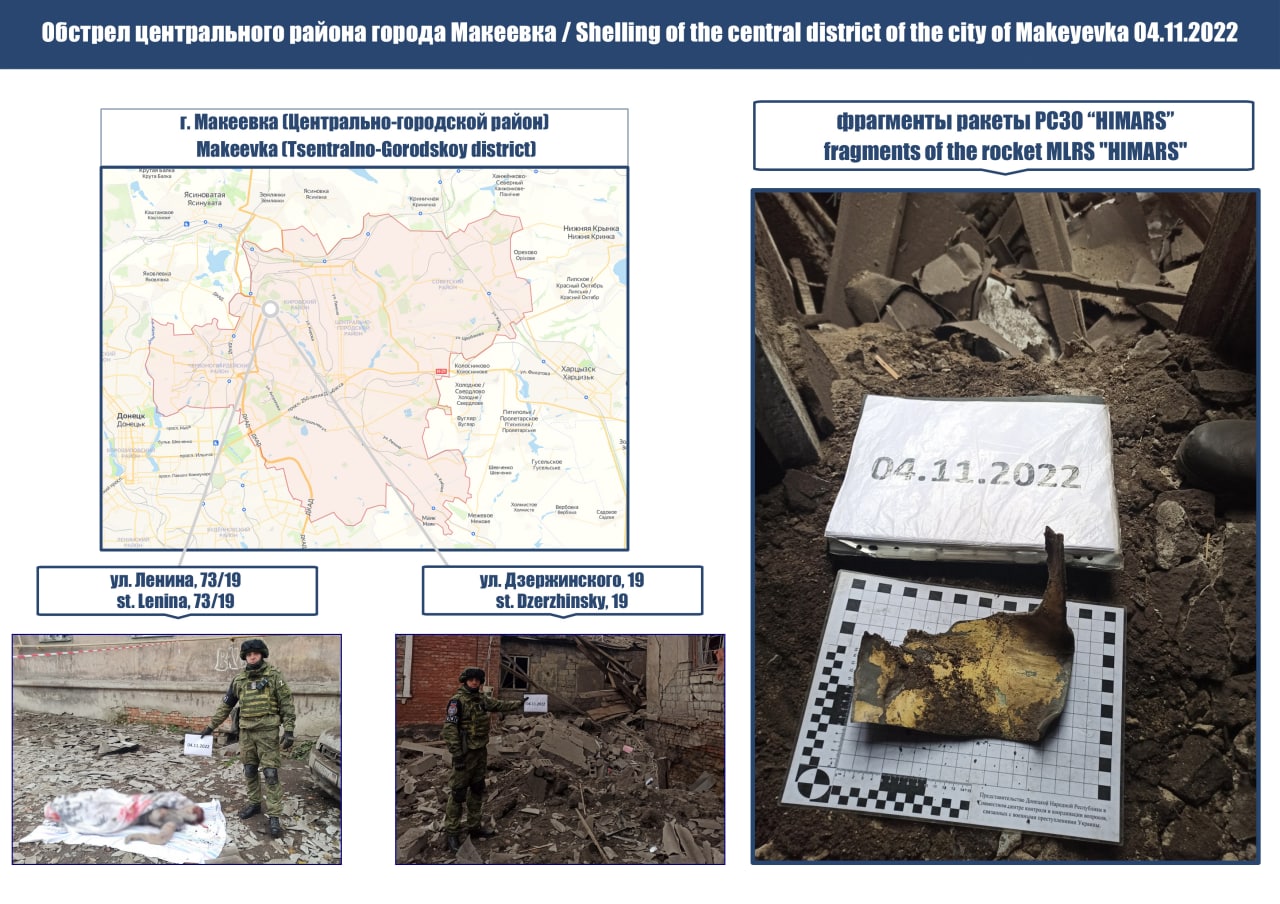
And to say the least, the civilian death toll from Western arms supplies to Ukraine is disastrous, as Natalia Shutkina, deputy head of the DPR mission to the CCCC, said.
“Kiev officials are trying to convince the international community that the weapons supplied by the West are being used allegedly to “defend its sovereignty” and exclusively on military targets. Alas – this is far from the reality. Since NATO countries started supplying arms to Ukraine, military terror has taken on an unprecedented scale: we have seen a fourfold increase in civilian casualties and a threefold increase in civilian destruction,” said Ms Choutkina.
Since 27 November 2022 alone, the Ukrainian army has fired more than 2,800 shells and rockets into residential areas of the DPR, partly with Western weapons, causing numerous civilian casualties in Donetsk, Gorlovka, Makeyevka, Yassinovataya and Elenovka. The bloodiest day was undoubtedly 6 December 2022, when the Ukrainian armed forces ‘celebrated’ their professional holiday by killing eight civilians and wounding 21 in the Donbass, destroying 53 residential buildings and 29 social infrastructures.
And the total toll since 2014 is chilling. In more than eight years of war, more than 15,000 DPR inhabitants have died as a result of the conflict.
“Kiev does not stop its armed terror. Over these long years, more than 15,000 of our compatriots, including children, women and the elderly, have been killed in the DPR alone,” said Ms Choutkina.
She called the new round of escalation in the Donbass, which began on 17 February this year, the bloodiest in the entire conflict.
“Since 17 February 2022, Ukrainian armed forces have killed 4,527 civilians, including 154 children, and injured 4,317 people, including 274 children,” Chutkina said.
She also added that 12,476 homes and 2,516 civilian infrastructures have been damaged in the DPR during this period by deliberate shelling by the Ukrainian military.
“Given the precision of the rocket and artillery systems donated by the West, the evidence we have documented on the consequences of their use indicates a systematic and targeted use of these weapons to specifically target civilian objects and civilians in their vast majority,” said Ms Choutkina.
Another fact that pleads for deliberate firing by the Ukrainian army to cause a maximum of civilian victims, whether with Western or Soviet weapons, is the time of day at which these bombings are carried out.
“Rocket and artillery fire from the Ukrainian armed forces takes place mainly in the morning, at lunchtime and in the evening, when people are travelling en masse to and from work, or during breaks when they go shopping, as well as at weekends, when people are shopping in markets and shops,” said Ms Choutkina.
These terrorist bombings by the Ukrainian army exclusively target civilian property and social infrastructure such as shops, markets, shopping centres, schools, kindergartens, cultural institutions and places of worship which are protected by the Geneva Conventions.
On 6 December, the Ukrainian army even used a high-precision M982 Excalibur guided artillery shell to bombard the Druzhba Sports Palace, where the distribution of drinking water to civilians is organized, because in February 2022 Ukraine cut off the Donbass from the only source of water supply – the Severski Donets Canal, which provides water to most of the Donbass. Such bombing can only be described as terrorist.
Indeed, some weapons, such as the US Himars multiple rocket launchers, are used extensively against civilian targets according to CCCC data.
“The first use of Himars on the territory of Donbass was documented on 28 June in Perevalsk (LPR). From that day until 10 December 2022 (5 months), a total of 185 attacks with Himars rocket launchers were carried out against civilian objects,” the CCCC noted.
This total is divided into 34 attacks on the territory of the DPR and 151 (556 rockets) on the territory of the LPR. These data clearly indicate that the weapons supplied by the West to Kiev are not used at all to defend the territorial integrity of Ukraine, but to massacre and terrorise the population of Donbass!
“Since the start of deliveries of US M142 Himars multiple rocket launchers to Ukraine, 556 deadly missiles have been fired at the territory of the LPR since 24 June. The LPR representative office in the CCCC has recorded attacks by high-explosive (M31) and tungsten-fired (M30A1) rockets. The main targets of the rocket attacks are dormitories, agricultural enterprises, industrial premises and educational institutions,” said Alexei Getmansky, an LPR military expert in the CCCC.
The CCCC also explained the tactics used by the Ukrainian army to carry out its bombardments, among others with the Himars multiple rocket launchers: firing mainly at night with the simultaneous use of other simpler artillery pieces to saturate the anti-aircraft defense.
“Often the operation of the system (Himars) is covered by several salvos of simpler systems – artillery or Soviet-style multiple rocket launchers. Their task is to distract and exhaust the anti-aircraft defenses with ‘secondary’ targets as the Himars are launched. This was the case, for example, during the first bombardment of the DPR chief’s administration building, when the enemy first fired two rounds of 155mm artillery systems at this location, followed a few minutes later by Himars missiles,” the CCCC report said.
Air defense specialists pointed out that after each launch, the Himars system is quickly moved to a shelter, and the next launch is carried out from other positions. As a rule, the movement and operation of the launchers takes place at night. According to statistics, the Himars were used 21 times during the night and 13 times during the day against the DPR. LPR territory was attacked 81 times at night and 70 times during the day. The purpose of this night firing is of course to minimise the risk of destruction of the multiple rocket launcher.
As can be seen, the Western weapons supplied to Ukraine are not at all used to defend itself against Russia, but to kill as many civilians as possible in the Donbass. Clearly, the NATO countries that supply arms to Kiev are complicit in Ukraine’s war crimes, and the taxes of the citizens of these countries are used to murder innocent civilians.
Translation Vz yan for Donbass Insider
https://libya360.wordpress.com/2022/12/ ... n-weapons/
*******************
Please excuse poor editing, I gotta lay down.
